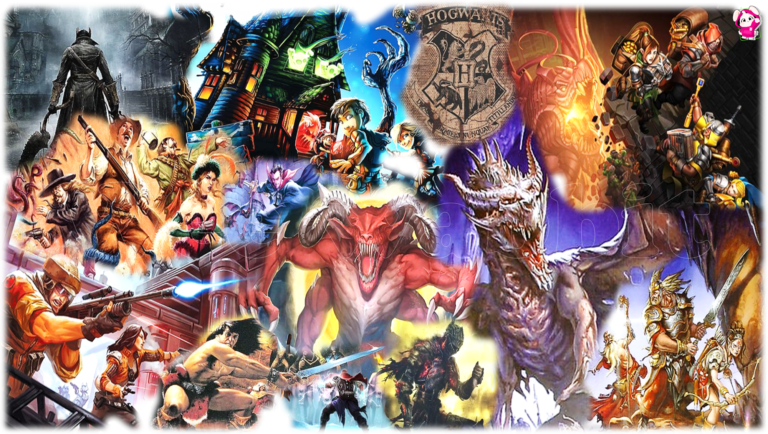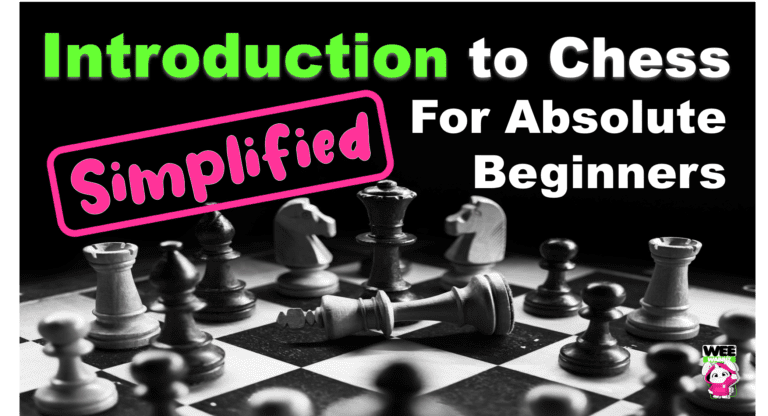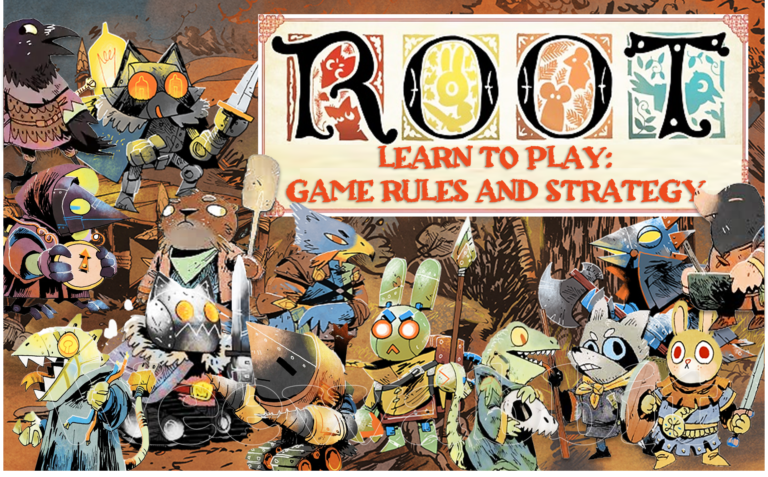Bang! “Samurai Sword” is a captivating multiplayer card game that transports players to the vibrant heart of feudal Japan. Crafted for 3-7 players, the game masterfully blends elements of strategy and chance, casting players in the roles of samurais, ninjas, or ronins, each harboring secret agendas and unique abilities. It’s easy enough for anyone to pick up and play but also packed with enough depth to keep you coming back for more. Another testament to Emiliano Sciarra‘s creativity.
Samurai Sword

“Bang! Samurai Sword”, still carries the spirit of our favorite Bang! card game, but this time in ancient feudal Japan setting. A time when characters like Shogun, Samurai, Ninjas, and Ronin play pivotal roles. Players adopt these iconic roles, each charged with their own crucial tasks, some aim to protect the empire, while others secretly work towards its demise.
Roles and their Objectives

Each player adopts a specific role, with unique goals and strategies. Getting to know these roles is essential for mastering the game and outsmarting your rivals.
Let’s visit each roles, their objectives, and how to play each effectively.
Shogun

The Shogun is the leader and protector. The Shoguns goal is to maintain control and safeguard its Samurai allies.
The Shogun’s identity is known to all players, making this role both powerful and vulnerable.
How to Play as the Shogun?

As the Shogun, your role is out in the open from the very start, so use this to your advantage by leading your Samurai openly. Always be on guard for attacks, especially from Ninjas.
Samurai

Loyal warriors sworn to protect the Shogun. As a Samurai, you work closely with the Shogun to eliminate the Ninjas and Ronin.
How to Play as the Samurai?

Samurai need to stay coordinated with the Shogun, working together to fend off attacks. Always be ready to intervene if the Shogun is targeted. Your role is vital in maintaining the team’s defense and ensuring the Shogun’s plans are executed smoothly.
Ninjas

Secretive and deceptive, Ninjas aim to overthrow the Shogun. They work in shadows, making them unpredictable foes.
How to Play as the Ninjas?

Keep your role a secret as long as possible while you work to undermine the Shogun’s team. Strike swiftly and retreat, keeping your actions unpredictable.
Ronin

The wild card of the game, Ronin plays for personal glory. With no allegiance, the Ronin’s objective is to be the last man standing.
How to Play as the Ronin?

As a Ronin, you’re on your own. Be flexible, adapt to the game’s flow, and choose your moments to strike carefully, aiming to outlast everyone else.
Characters and their Abilities

Each character has a unique ability that helps them in the game. These abilities can make them stronger in attacks, better at defending, or give them special actions they can use.
Before we introduce our list of characters and their abilities, let’s’ breakdown a character card first.
Character Card Breakdown

Our sample character card above is USHIWAKA.
Resilience Points

The number (4) at the top right corner of the card within a heart, indicates how many wounds Ushiwaka can take before becoming defeated (Harmless). Meaning, Ushiwaka can withstand up to four wounds.
Resilience Points essentially represent the character’s health.
Ability

“Each time you suffer 1 wound from a Weapon, draw 1 card from the deck.” This ability allows Ushiwaka to draw a card from the deck every time he is hit by a weapon.
Ability represents the unique power or special skill that the character has.
Here are Bang! Samurai Swords’ characters and their abilities.
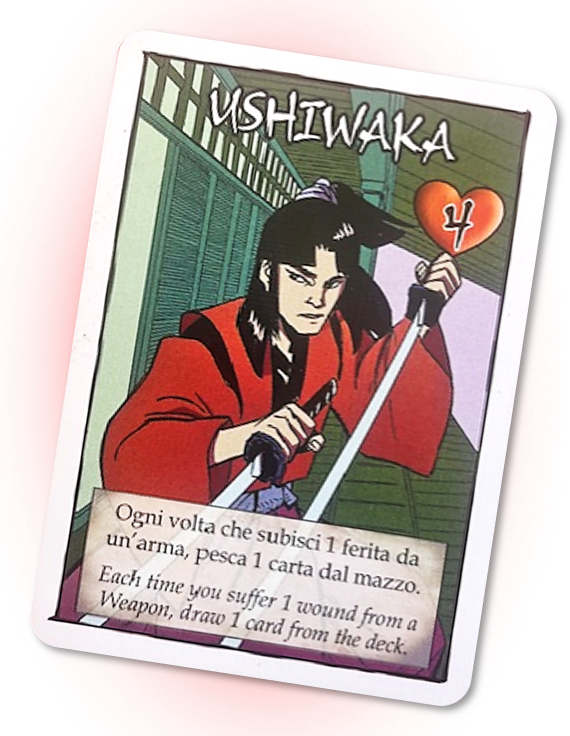
Every time Ushiwaka gets a wound from a Weapon, he draws a card. This helps him replace his cards whenever he’s attacked, turning a bad situation into a benefit.
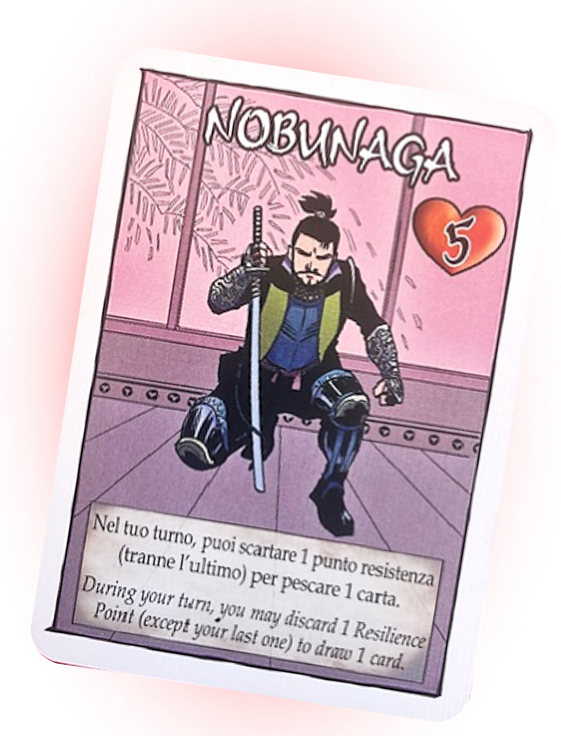
Nobunaga can give up one Resilience Point to draw a card, but he can’t use his last Resilience Point this way. This gives him a chance to draw more cards even if it means risking his defenses..
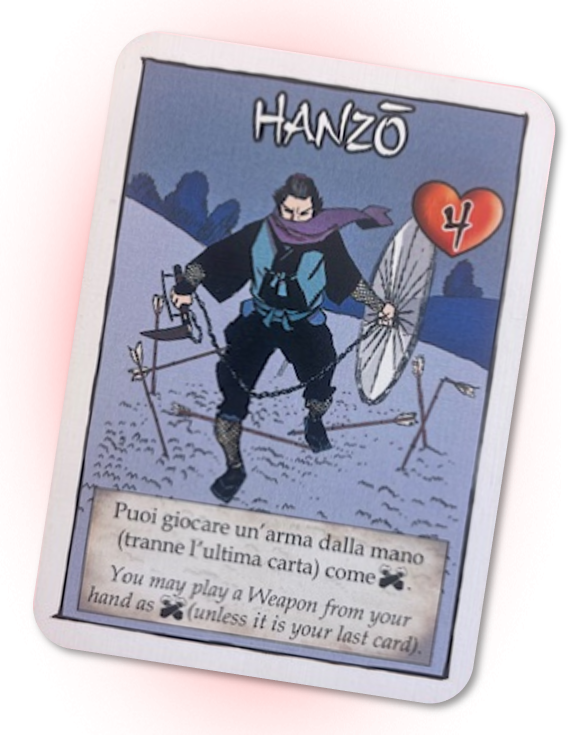
Hanzo can use a Weapon card from his hand to block an attack aimed at him. This ability to parry makes him good at defending himself during battles.
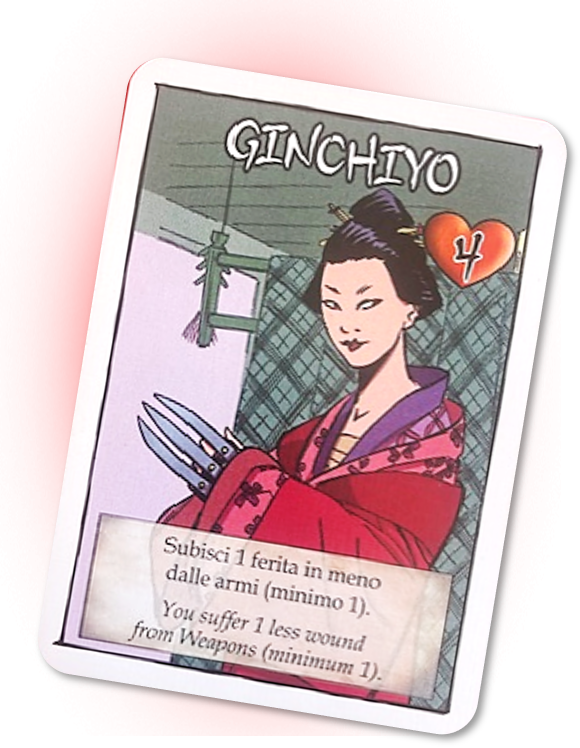
Ginchiyo receives one less wound from each attack, with a minimum of one wound. This ability makes her harder to take down, especially in heavy attacks.
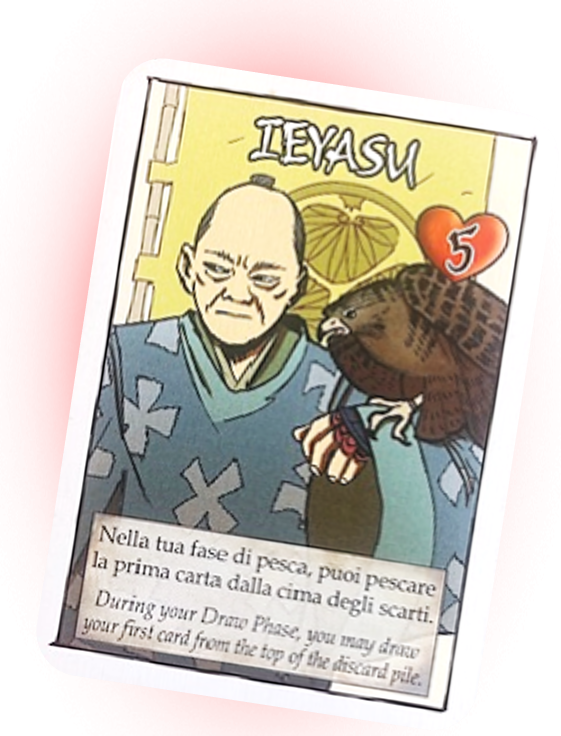
Ieyasu can choose to pick the top card from the discard pile instead of drawing from the deck during his Draw phase. This lets him reuse powerful cards that were discarded earlier.
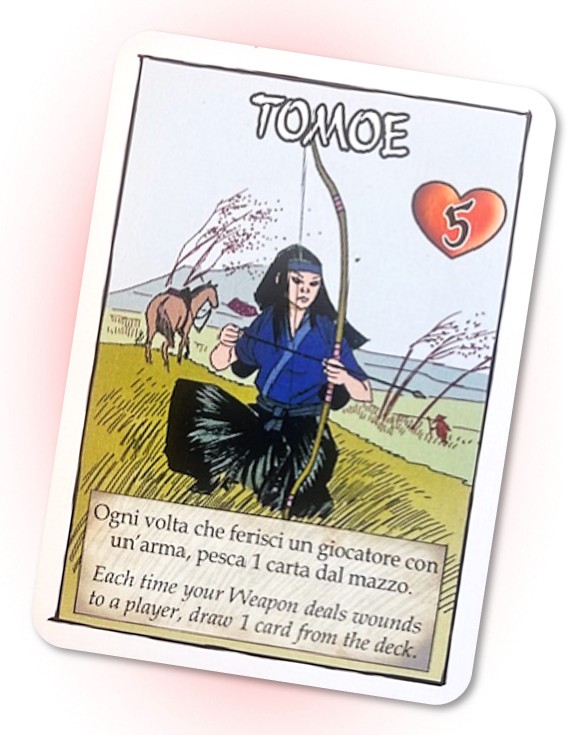
When Tomoe successfully attacks with a Weapon, she gets to draw a card. This keeps her supplied with more cards to use in the game.
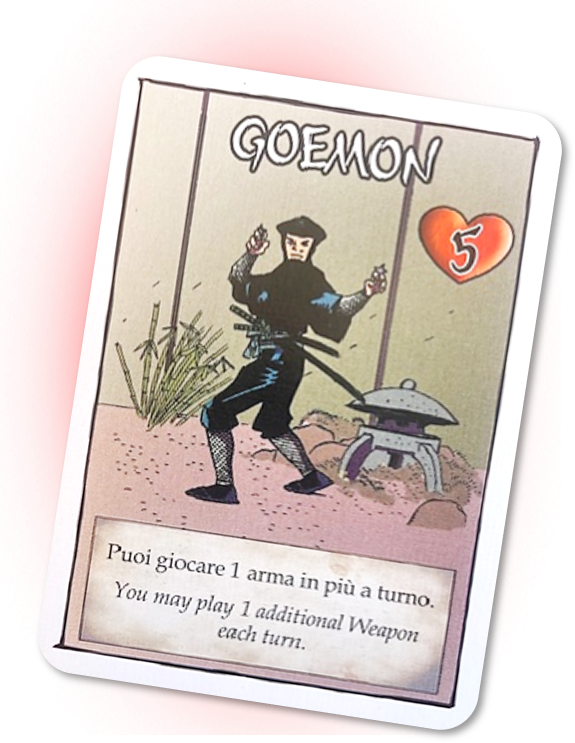
Goemon can play one extra Weapon card during his turn. This lets him attack more than once in a round, making him a dangerous opponent.

Kojiro’s weapons can hit any target, no matter the required Difficulty. This makes him a very effective fighter who can always manage to hit his targets.
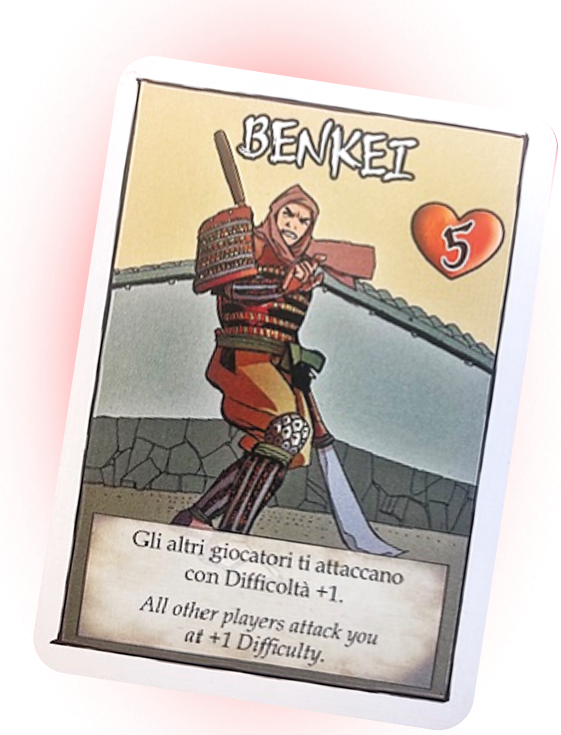
All other players have +1 Difficulty when attacking Benkei, making him tougher to hit and enhancing his defensive resilience in battles.
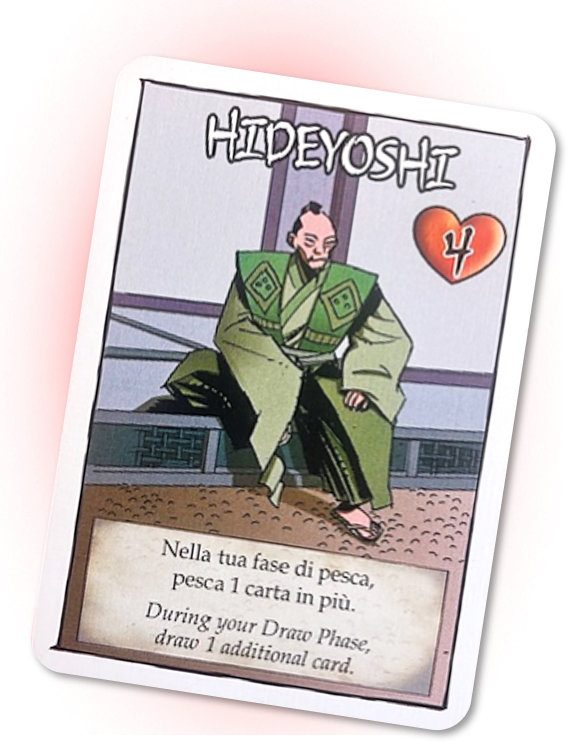
Hideyoshi gets to draw one extra card during the Draw phase. More cards mean more options, helping him plan better strategies.

Musashi deals one extra wound when attacking with weapons. This makes him very strong in battles, helping him weaken his enemies faster.
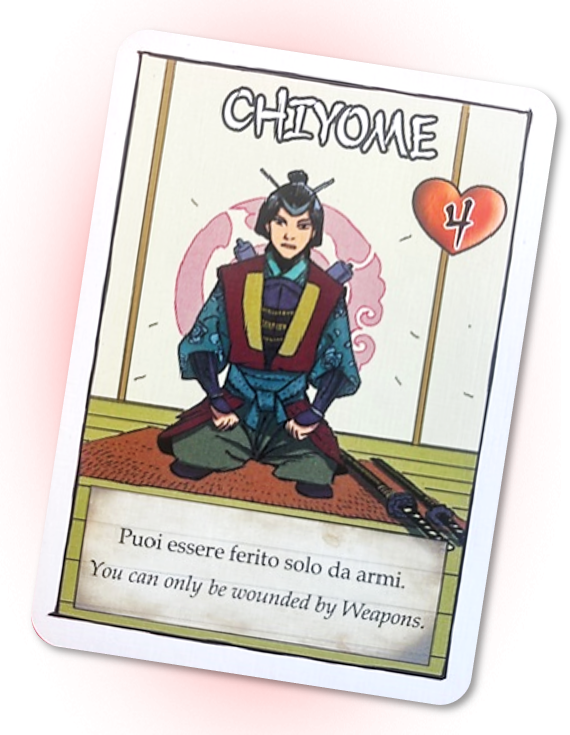
Chiyome can only be hurt by Weapon cards and is safe from effects of some Action cards like Battle Cry. This makes her tough to defeat with special attacks.
3 Types of Playing Cards
There are three main types of playing cards that you’ll use to play the game: Weapon Cards, Property Cards, and Action Cards. Each type of card has a specific role and can greatly affect how the game unfolds. Knowing how to use these cards well is essential for winning the game and outwitting your opponents.
Weapon Cards

Weapon Cards are special cards in the game that you use to attack other players then discarded after. Weapon cards are the ones with red corners.
Weapon Cards and Attack Difficulty
Before we attack. let’s know how to measure difficulty first…
ATTACK DIFFICULTY
When you attack another player with a Weapon card you need to first check the Attack Difficulty. This tells you how hard it is to hit another character.

Imagine you and your friends are sitting in a circle playing the game. Attack Difficulty is just a fancy way of saying how far away your target is from you around that circle. Each spot between you and them adds to the difficulty. So, if your friend is sitting two spots away from you, the Attack Difficulty is 2. This number tells you how hard it will be to hit them with your weapon.

Some players might be “Harmless,” which means they can’t be attacked because they’re out of health points or cards. They don’t count when you’re figuring out how far away other players are.
Now that we know how to measure attack difficulty, we can now refer to a weapon cards difficulty range and damage it can inflict. Here’s a breakdown of a weapon card…
Weapon Cards Breakdown

The number at the top of the card indicates how far the weapon can reach, either clockwise or counterclockwise.
The number at the bottom of the card indicated how much damage a weapon inflicts to the targeted player if the attack is successful.
Here are the different WEAPON CARDS we’ll encounter in the game.
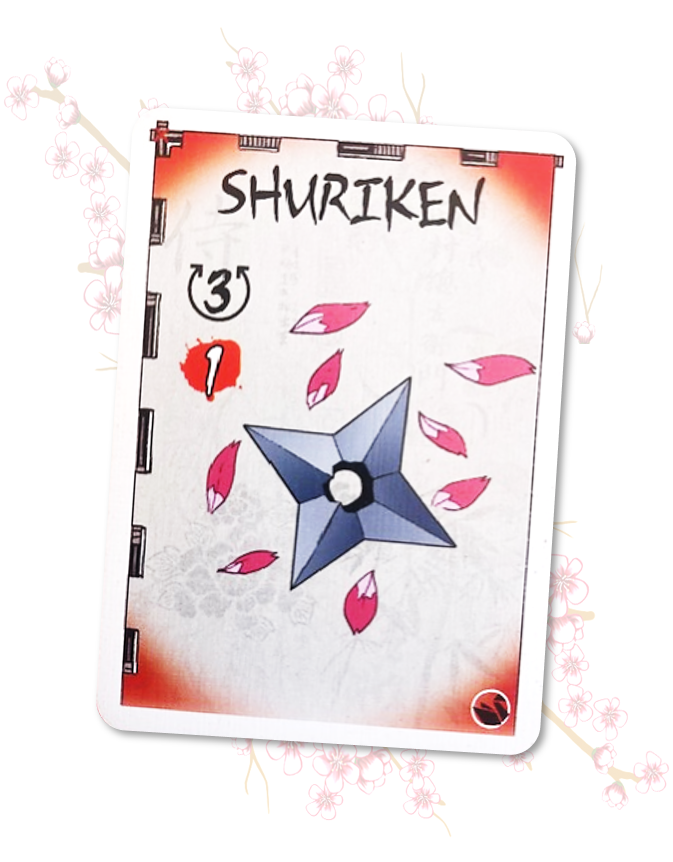
Difficulty: 3
Wounds Inflicted: 1 wound
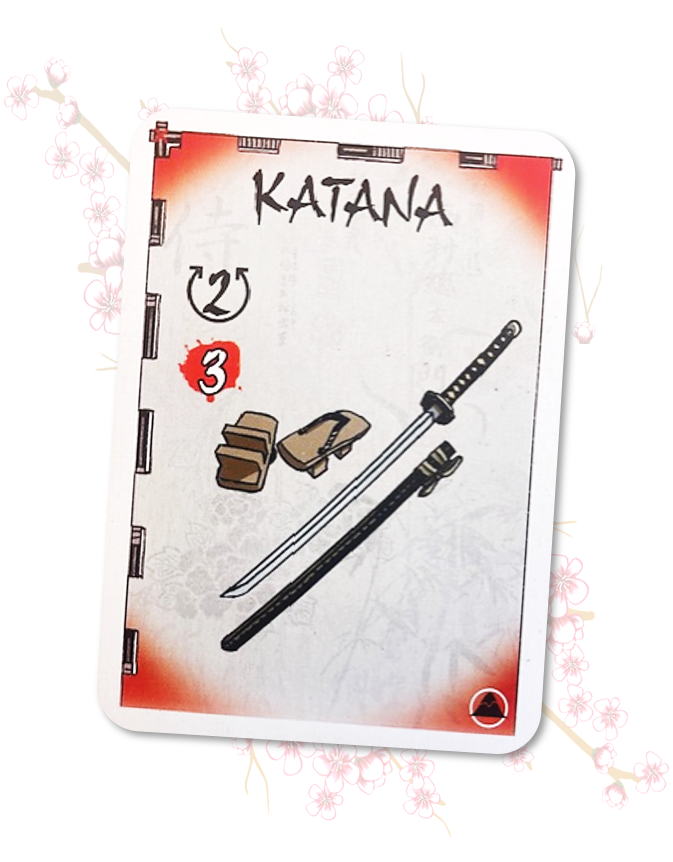
Difficulty: 3
Wounds Inflicted: 3 wounds

Difficulty: 1
Wounds Inflicted: 3 wounds
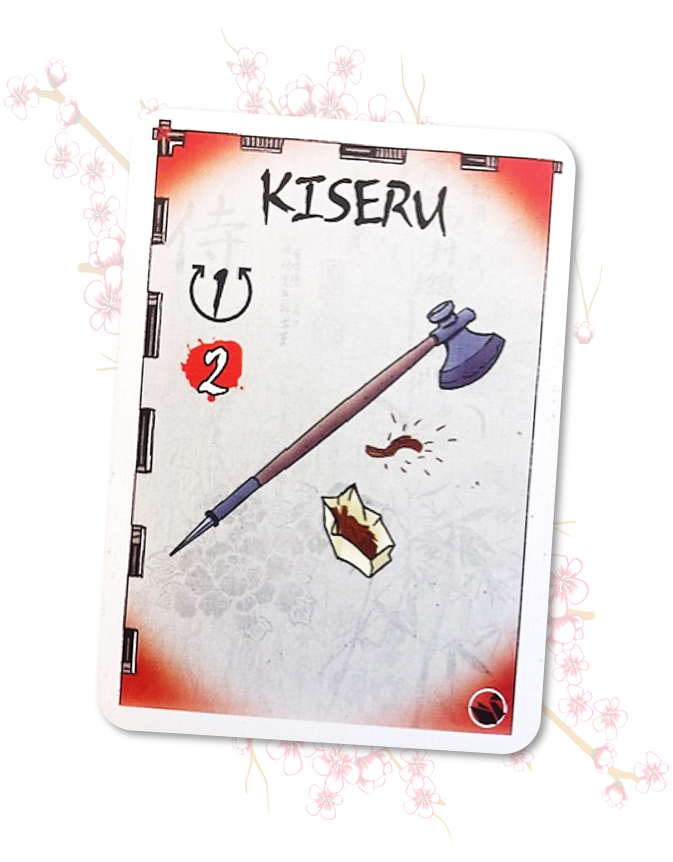
Difficulty: 1
Wounds Inflicted: 2 wounds
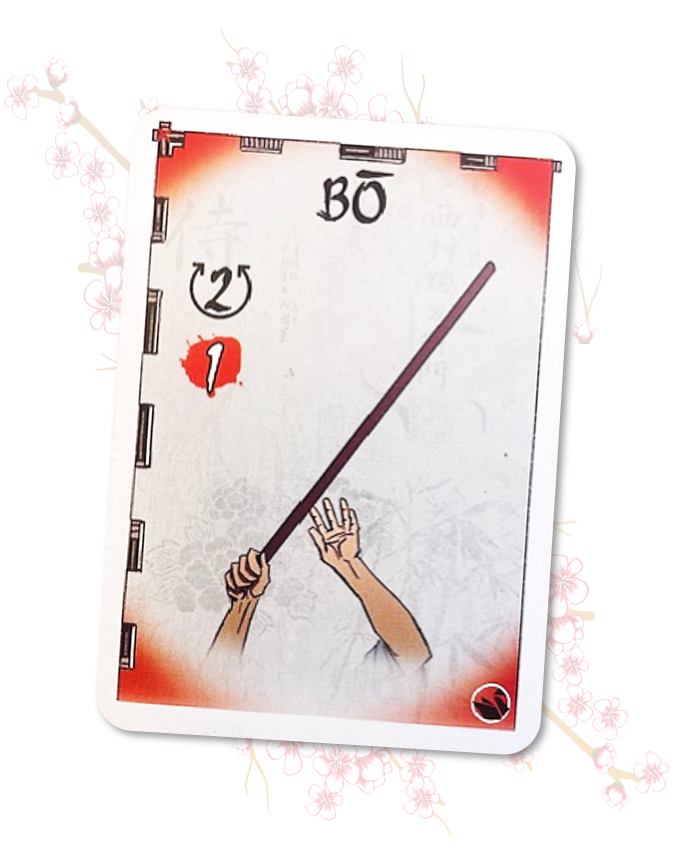
Difficulty: 1
Wounds Inflicted: 2 wounds
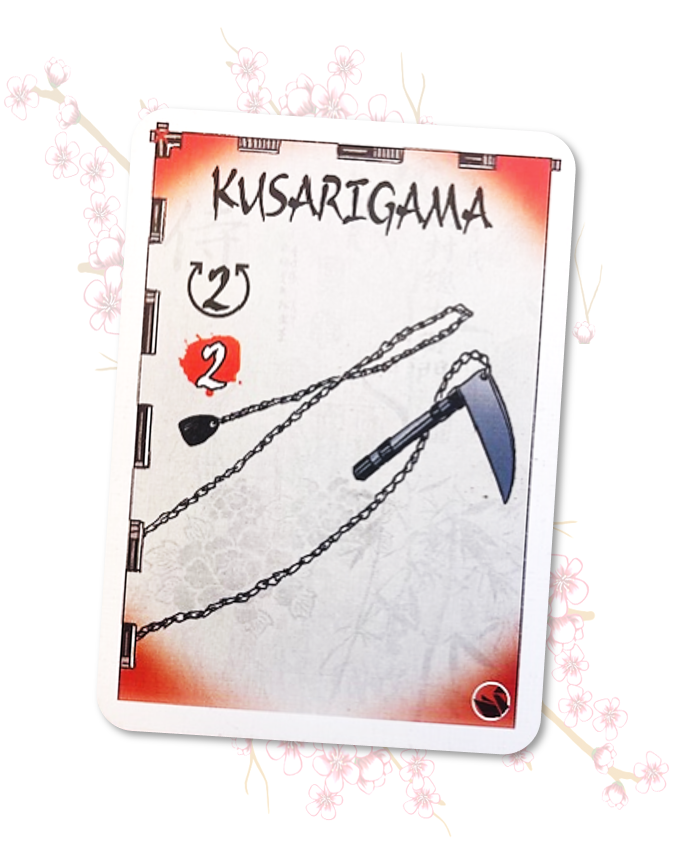
Difficulty: 2
Wounds Inflicted: 2 wounds
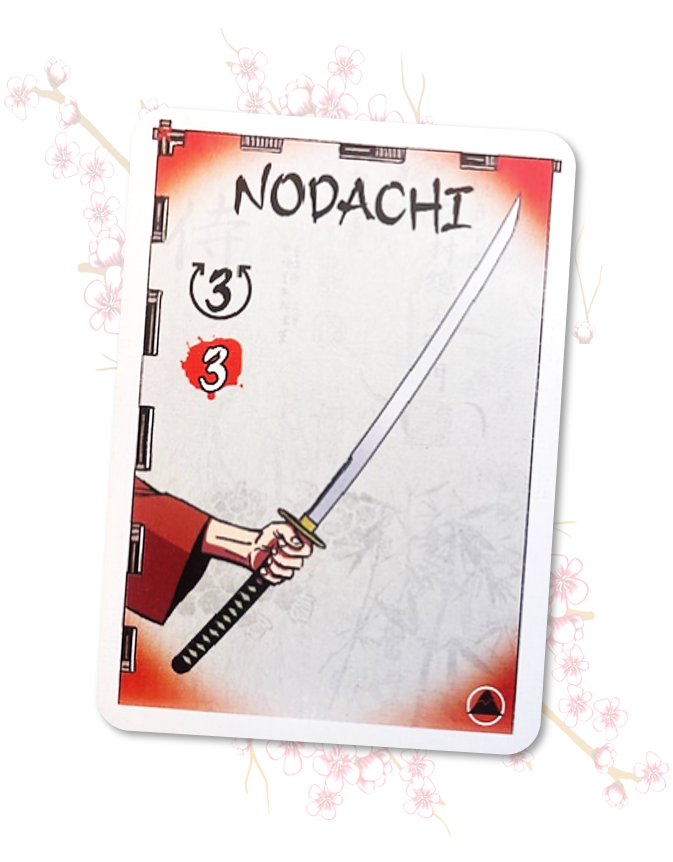
Difficulty: 3
Wounds Inflicted: 3 wounds

Difficulty: 2
Wounds Inflicted: 1 wound
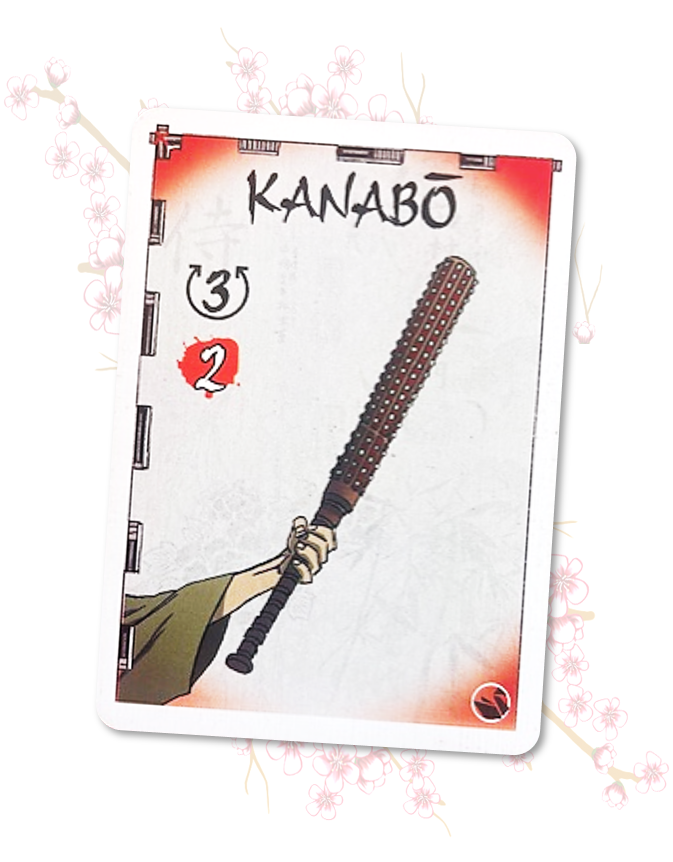
Difficulty: 3
Wounds Inflicted: 2 wounds
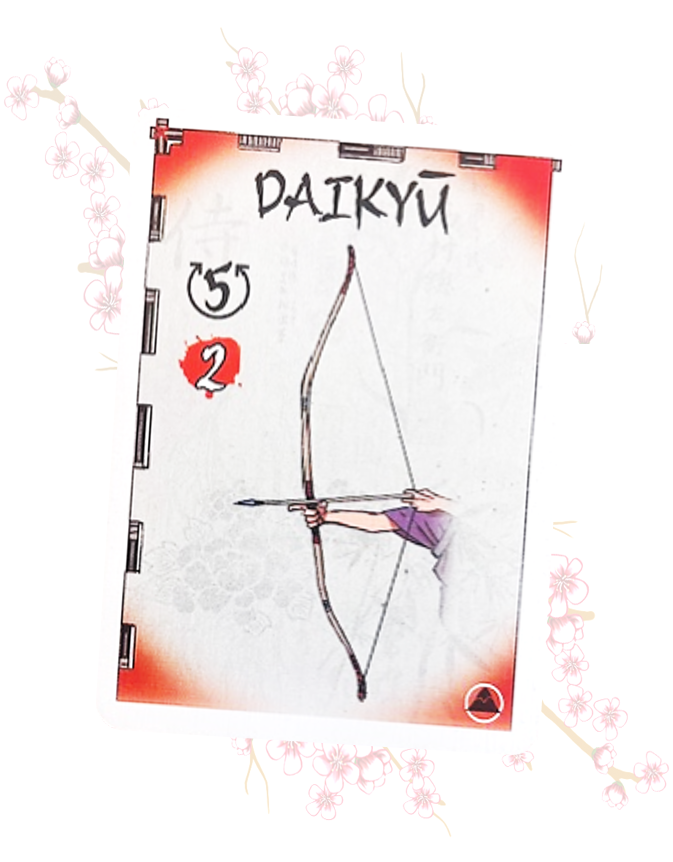
Difficulty: 5
Wounds Inflicted: 2 wounds
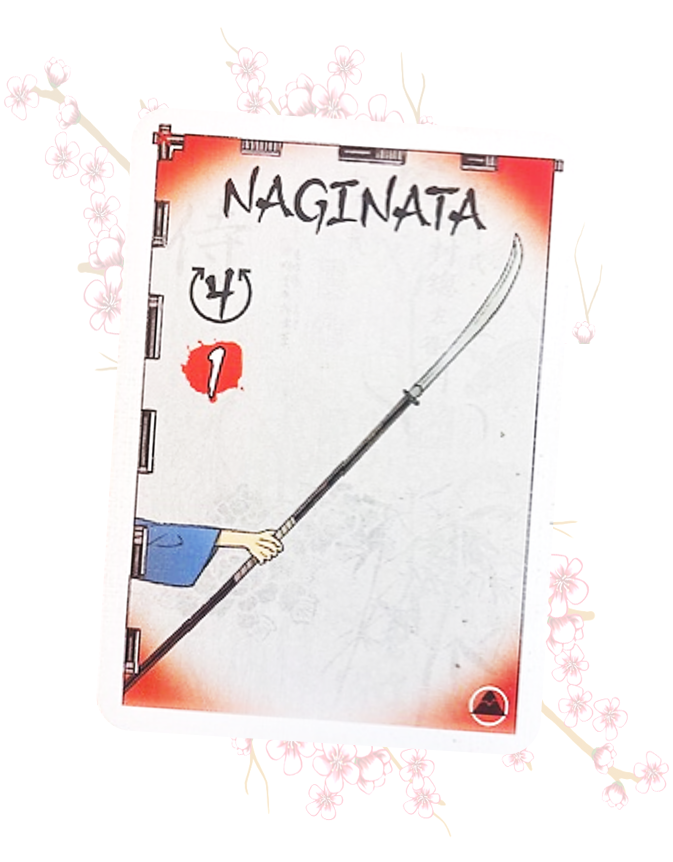
Difficulty: 4
Wounds Inflicted: 1 wound
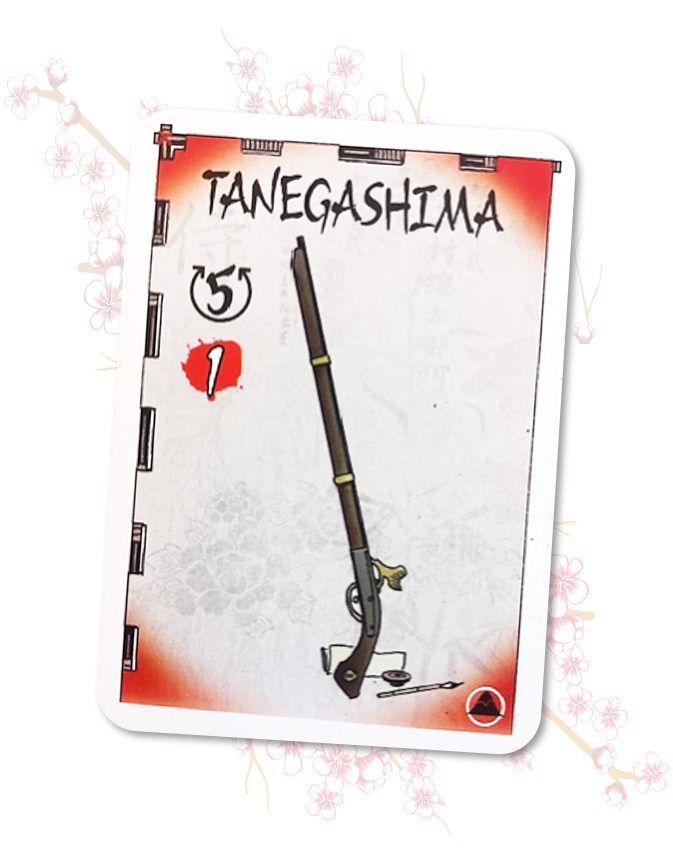
Difficulty: 5
Wounds Inflicted: 1 wound
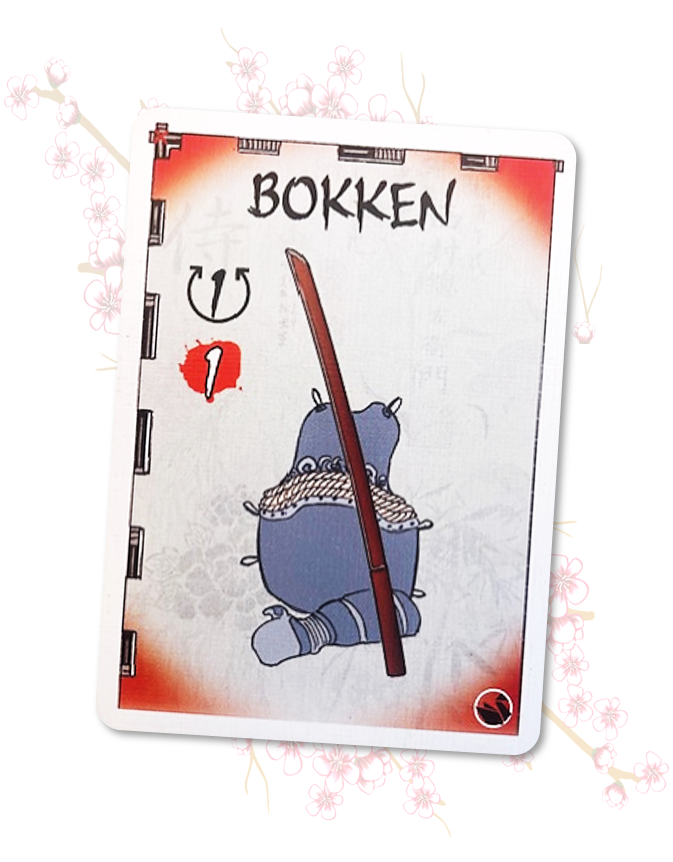
Difficulty: 1
Wounds Inflicted: 1 wound
Property Cards

Property Cards are special cards that give you ongoing benefits throughout the game. Unlike Weapon Cards that are used once and then discarded, Property Cards stay in play in front of you until a specific game effect or another card forces them to be discarded.
Once you play a Property Card, it stays on the table and keeps giving you its benefit until something in the game forces you to discard it. These benefits can include things like extra defense, the ability to draw more cards, or other advantages that help you throughout the game. Property cards have blue corners.
Here are the different PROPERTY CARDS we’ll encounter in the game.
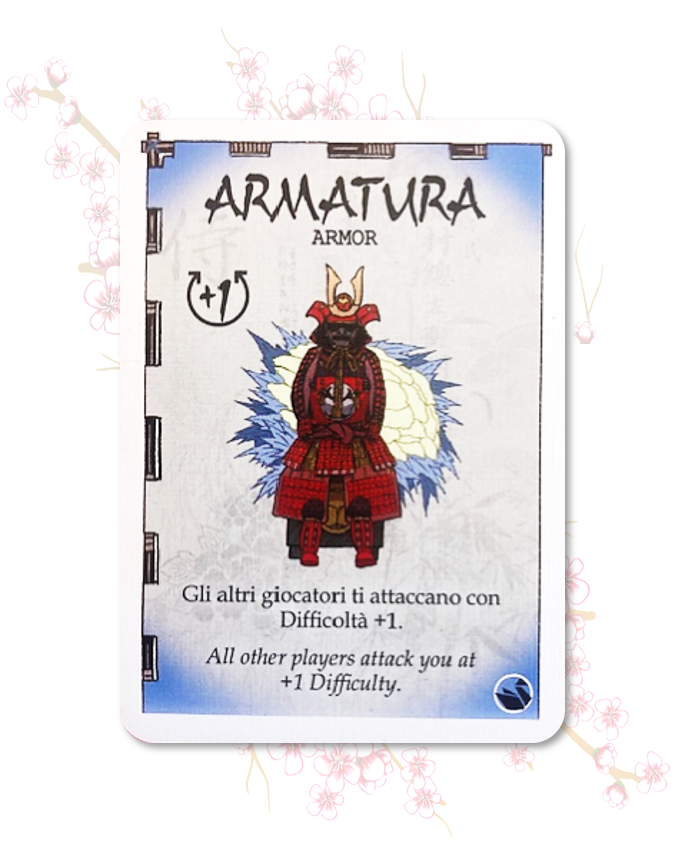
All other players attack you at +1 difficulty. This provides a defensive advantage, making it harder for other players to successfully hit you.
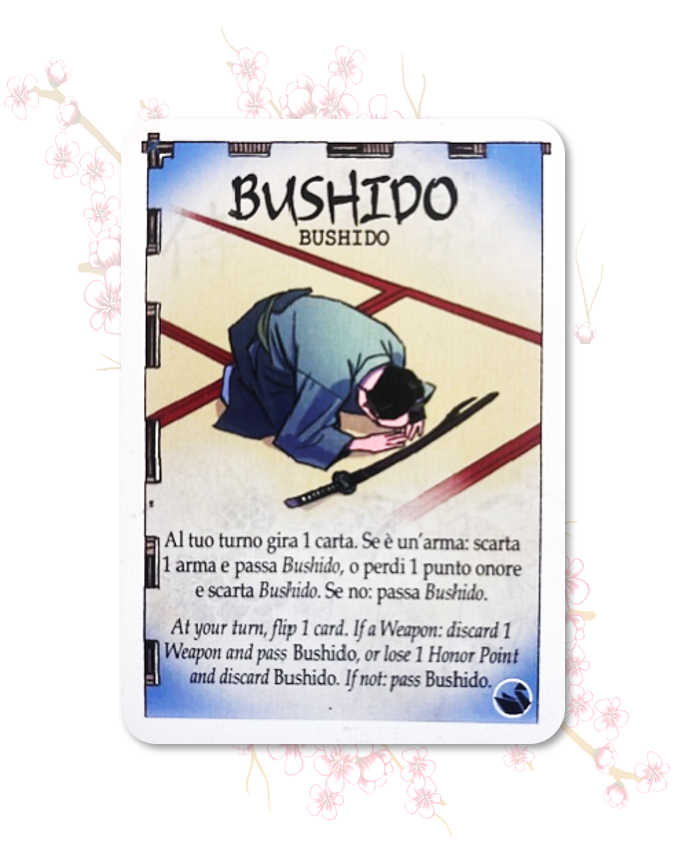
At your turn, flip 1 card. If it’s a weapon, discard 1 weapon and pass Bushido, or lose 1 Honor Point and discard Bushido. If not, just pass Bushido. This card tests your preparedness and can potentially force you to make a significant decision about retaining your honor or your weapons.
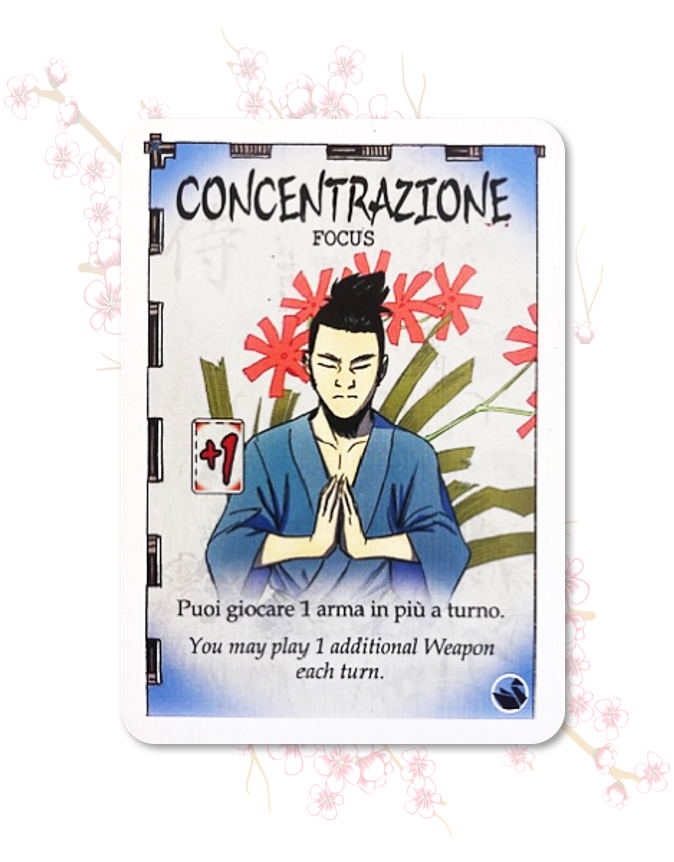
You may play 1 additional weapon each turn. This property allows for more aggressive strategies by letting you attack more frequently.
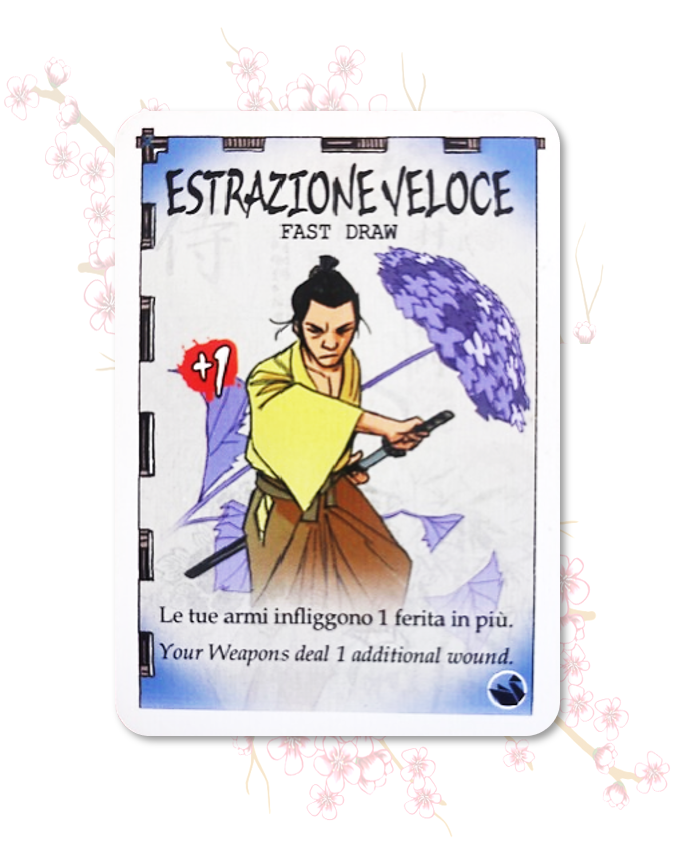
Your weapons deal 1 additional wound. This enhances your offensive capabilities by increasing the damage dealt by your weapons.
Action Cards

Action Cards provide instant effects once played and can dramatically alter the game’s progress. These effects include, but are not limited to, attacking, defending, or altering game rules for brief periods.
Action Cards are vital for engaging gameplay and can significantly impact the game’s direction. Action cards are those with yellow corners.
Here are the different ACTION CARDS we’ll encounter in the game.
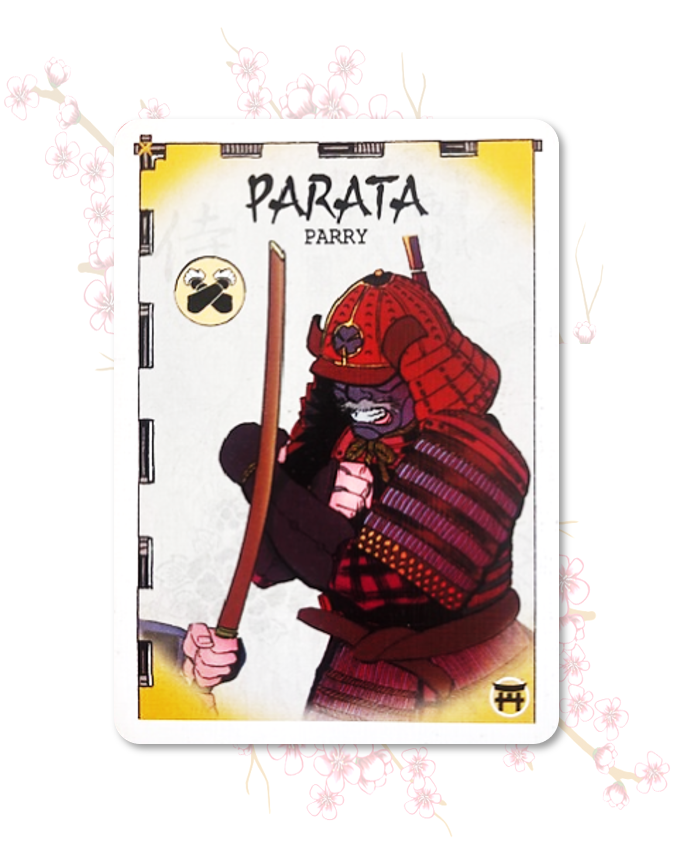
Acts as a defense against an attack, potentially negating or modifying the effect of the attack.
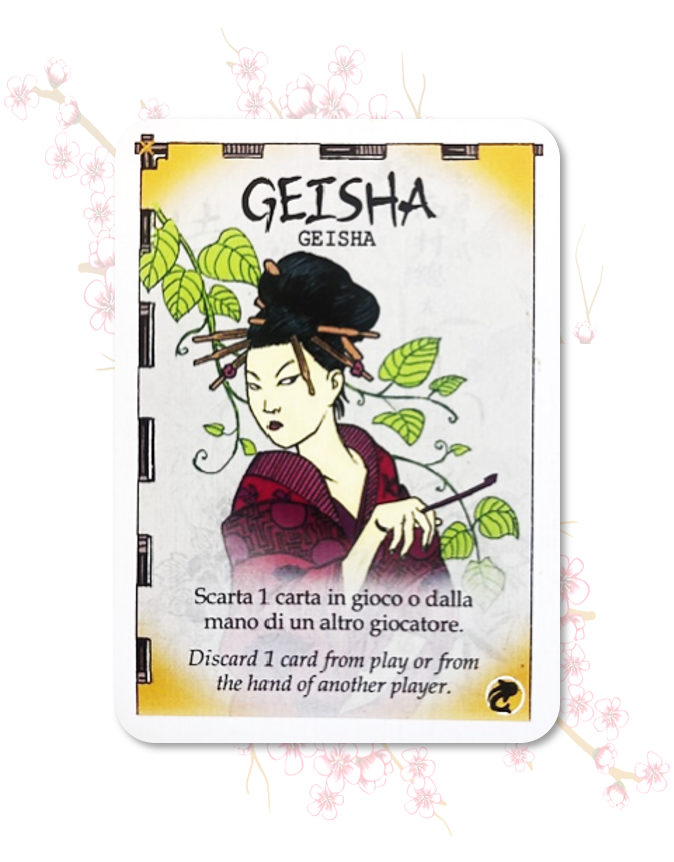
Take 1 card in play or from the hand of another player. Allows you to strategically remove a key card from another player’s hand or the play area.

All other players choose to discard 1 Weapon or suffer 1 wound. This card forces all opponents to make a difficult choice, potentially disrupting their plans or weakening them.
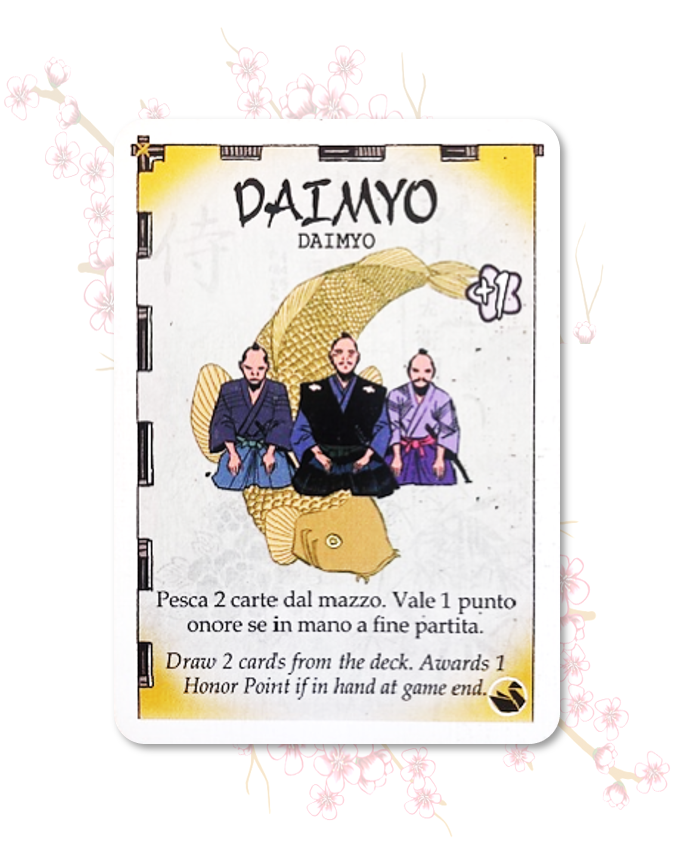
Draw 2 cards from the deck. Awards 1 Honor Point if held in hand at game end. This card boosts your card resources and provides a potential point advantage.
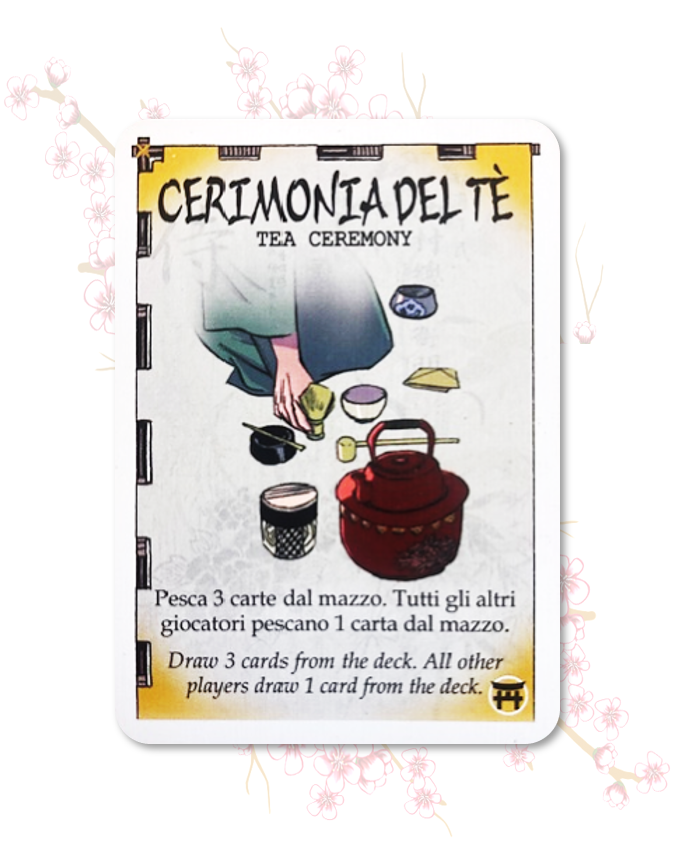
Draw 3 cards from the deck. All other players draw 1 card from the deck. It not only benefits you with additional cards but also gives everyone else a smaller benefit, maintaining some balance.
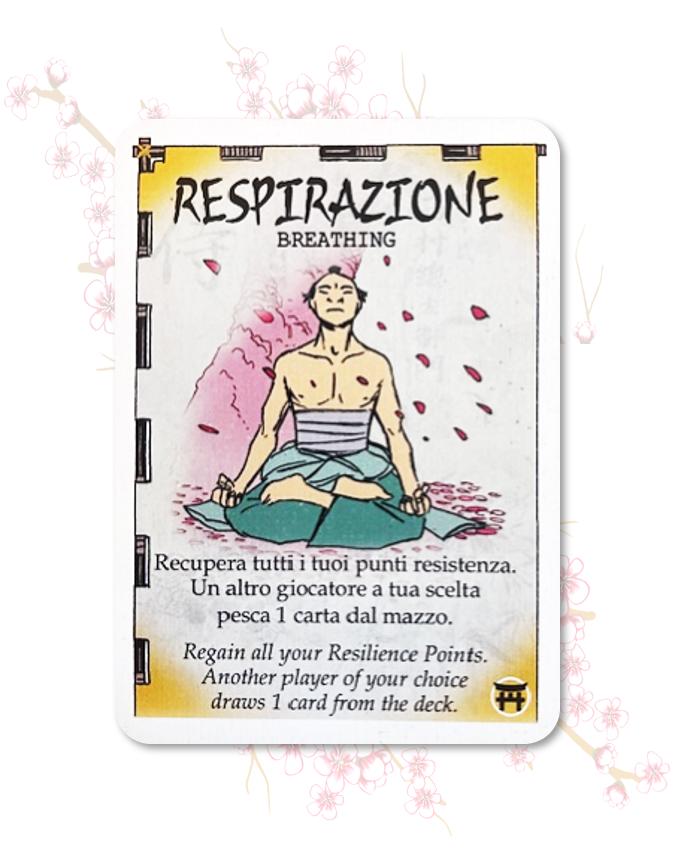
Regain all your Resilience Points. Another player of your choice draws 1 card from the deck. This card helps in recovery and also benefits another player, promoting some strategic alliance.
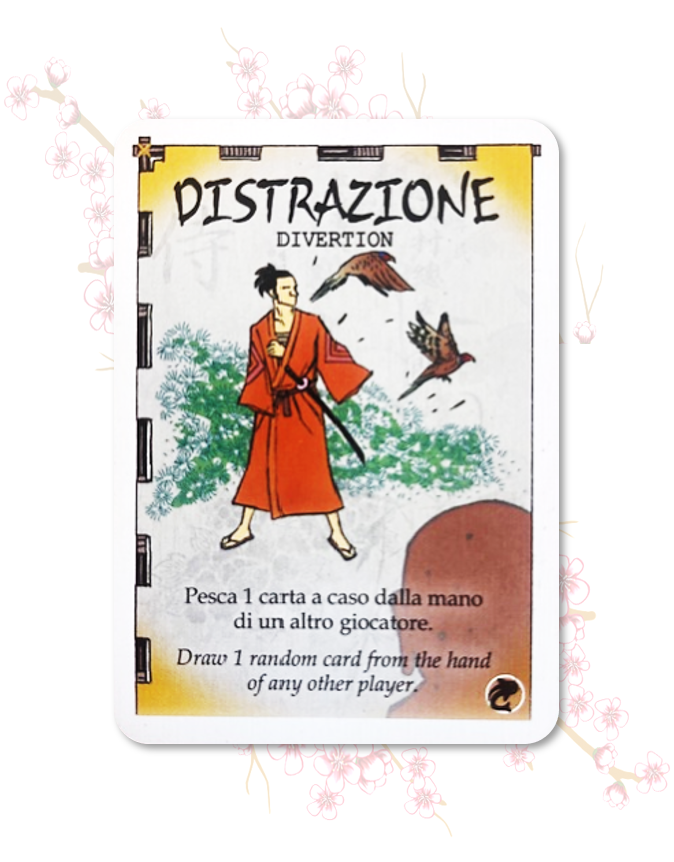
Draw 1 random card from the hand of any other player. This disrupts another player’s strategy by taking one of their cards.
How to Play
Setting Up
1. Set Up Role Cards

First, determine the number of players. The image guide above is the distribution of roles for the number of players. Based on the number of players, take the appropriate Role cards:
- 4 players: 1 Shogun, 1 Samurai, 2 Ninjas (remove one Ninja at random).
- 5 players: 1 Shogun, 1 Samurai, 1 Ronin, 2 Ninjas.
- 6 players: 1 Shogun, 1 Samurai, 1 Ronin, 3 Ninjas.
- 7 players: 1 Shogun, 2 Samurai, 1 Ronin, 3 Ninjas.
2. Distribute Role Cards

Shuffle the Role cards and deal one to each player face down. The Shogun reveals their card. Other players keep their roles secret.
Give out Honor Points based on roles.
Shogun: Starts with 5 HP.
All other players: Each start with 4 HP.

3. Shuffle Character Cards

Shuffle the Character cards and deal one to each player face up. Each player announces their character and places the Resilience Points (RP) shown on their card.
Each player takes the number of Resilience Points (RP) indicated on their Character card and places them on their card.

The Shogun follows the same character setup process as the other players, without any additional RPs unless specified by their Character card.
4. Distribute Playing Cards

Shuffle the 90 playing cards and deal cards to each player in clockwise order’
Number of Cards Each Player Receives:
- Shogun: Gets 4 cards.
- 2nd and 3rd Players: Each gets 5 cards.
- 4th and 5th Players (if present): Each gets 6 cards.
- 6th and 7th Players (if present): Each gets 7 cards.
Place the remaining cards in the middle of the table, as the draw deck. Leave space for a discard pile.

This would be our table setup assuming we have 7 players.

Starting The Game

The game begins with the Shogun taking the first turn, and then turns proceed in a clockwise order from the Shogun. Below is what players does in a turn.
Turn Structure
Each player’s turn is divided into four phases: Recover, Draw, Play, and Discard.
Let’s start with the Recover Phase.
1. Recover Phase

In the Recover Phase, the objective is to recover your Resilience Points (RP). If you have zero Resilience Point, you will recover all as indicated on your Character card. However, if you already have one or more, you will skip this phase.
Next is the Draw Phase.
2. Draw Phase

In the Draw Phase, the objective is to draw cards to replenish your hand. You will draw 2 cards from the draw deck. If the draw deck is empty, you will reshuffle the discard pile to form a new draw deck. Additionally, if you are the Shogun in a 3-player game, you draw an extra card, totaling 3 cards.
Then, the Play Phase.
3. Play Phase

In the Play Phase, the objective is to use your cards to help yourself or hinder others. You can play any number of cards from your hand, including Weapon cards(see Weapon Cards), Action cards, and Property cards.
How you play a Property Card?
Property cards provide long-lasting effects that can significantly influence the game. Here’s a step-by-step guide on how to play them:

During your Play Phase, choose the Property card you wish to play from your hand. Place the Property card face-up in front of you on the table.
The effects of the Property card come into play immediately and remain active as long as the card is on the table.Property cards typically provide ongoing benefits, such as allowing you to play additional Weapon cards or modifying the effects of other cards.

Suppose you chose to play the Focus Property card, which allows you to play an additional Weapon card each turn. During your Play Phase, place the Focus card face-up in front of you. Now, each turn, you can play two Weapon cards instead of one, as long as the Focus card remains in play.
How you play a Action Card?
Action cards have immediate effects that can influence the game by helping you or hindering your opponents. It is discarded after the Action card’s effect has been resolved.

During your Play Phase, choose the Action card you wish to play from your hand. Place the Action card face-up on the table and announce its effect.

The effect of the Action card is applied immediately upon playing it. After the Action card’s effect has been resolved, place the card in the discard pile.
Example
Suppose you play the Jujutsu Action card during your Play Phase. The Jujutsu card forces each opponent to either play a Weapon card or suffer a wound.

The opponent chooses to either discards a Weapon card, or loose 1 Resilience Point (RP).
Announce the effect of the Jujutsu card and go around the table, having each opponent make their choice and apply the effect immediately. If an opponent is Harmless, they are unaffected by the Jujutsu card and do not need to make a choice. After all opponents have resolved the effect, discard the Jujutsu card into the discard pile.
What is a “Harmless Opponent?
A player is considered Harmless if they meet either of the following conditions:
No Resilience Points (RP): The player has lost all their RP, meaning they have been “Defeated” and cannot take any more damage.
No Cards in Hand: The player has no cards left in their hand to play.
When a player is Harmless, they cannot be targeted by Weapon cards and are unaffected by certain Action cards, such as Battle Cry and Jujutsu. Additionally, Harmless players do not count when determining the Difficulty of an attack. This status offers temporary protection, but it also limits the player’s ability to participate actively until they recover RP or draw more cards.
Last stage in a turn is the Discard Phase.
4. Discard Phase

In the Discard Phase, the objective is to manage your hand size. At the end of your turn, you must ensure that you have no more than 7 cards in your hand. If you have more, you need to discard the excess cards until you are left with 7. Then your turn ends, and the next player begins their turn.
Winning the Game
Ending The Game
The game can end in two main ways: when a player has no Honor Points (HP) left, or through a special victory condition called Victory of the Swordmaster.

Running Out of Honor Points
If one or more players run out of (Honor Points) HP, the game ends immediately.

Victory of the Swordmaster
If at any point there is only one player left with any Resilience Points (RP), their team wins immediately. This special victory does not apply if the game ends because a player was defeated by a member of their own team.
Scoring
At the end of the game, all players reveal their Role cards and calculate their scores as follows:

1. Count Honor Points (HP)
- Each player counts their remaining HP.
- Each player checks for any Daimyo cards in their hand, which are worth 1 HP each (Daimyo cards are worth 0 HP for the Ronin).
2. Apply Role Multipliers
- Shogun and Samurai Team:
- Shogun’s HP are multiplied by 2.
- Samurai’s HP are added to the Shogun’s total without multiplication.
- Ninjas:
- Ninjas add their HP together. In a 4-player game, the Ninja with more stars doubles their points.
- Ronin:
- Ronin’s HP are tripled.
3. Combine Scores for Teams
- The Shogun and Samurai combine their scores.
- The Ninjas combine their scores.
- The Ronin’s score stands alone.
4. Determining the Winner
- The team or player with the highest score wins.
- In the case of a tie:
- Ninjas win if tied with any other team.
- The Shogun and Samurai team win if tied with the Ronin.
Samurai Sword: Rising Sun
Expansion

Get ready to sharpen your swords and prepare for new challenges with the “Rising Sun” expansion for Bang! Samurai Sword. This exciting addition brings more action, strategy, and fun to your game table. “Rising Sun” adds cool new characters, powerful weapons, and some fun twists to the rules that make every game unpredictable and thrilling.
Let’s dive into what this expansion has in store and how it will change your Samurai Sword adventures!
Additional New Characters
Expansion
The expansion introduces 12 unique characters, each with their own special abilities that can turn the tide of battle. Let’s look at each one of them, shall we?
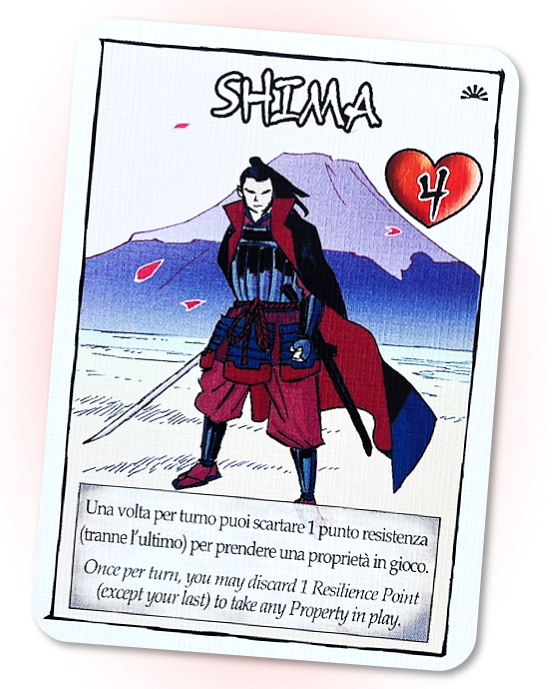
Shima can use his turn to mess with his own cards on the table, like Bleeding Wound or Curse, which can change how things are going during the game.
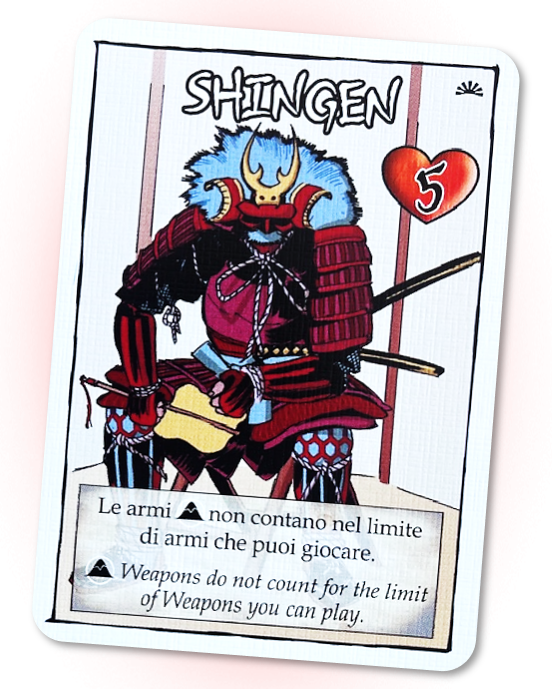
Shingen can use lots of weapons at once, more than anyone else. This makes him a strong attacker, especially if he has Focus cards in play.
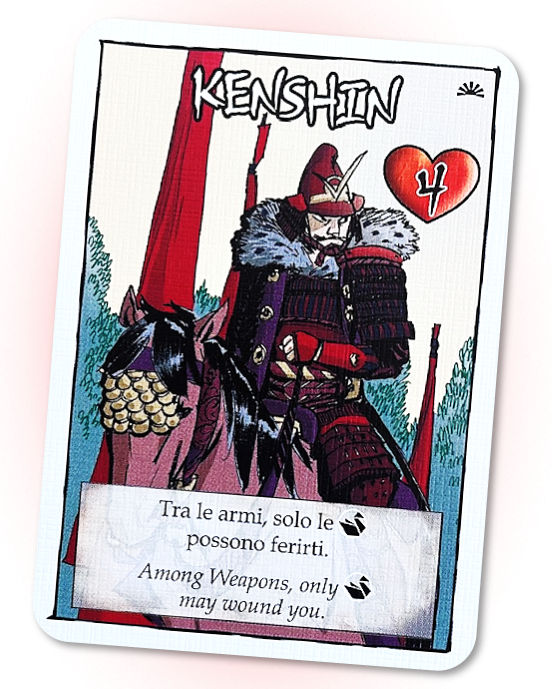
Kenshin can be targeted with weapon cards that have a different symbol, but they won’t hurt him.
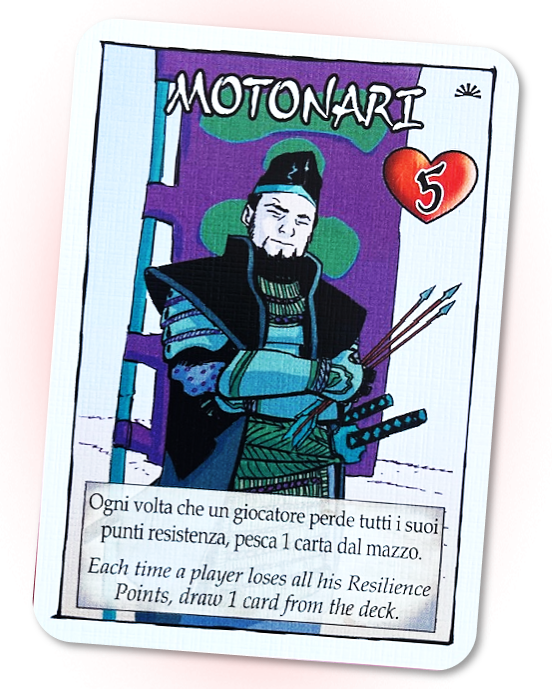
If he loses all his Resilience Points but not due to losing honor, his ability kicks in, making him tough to beat.
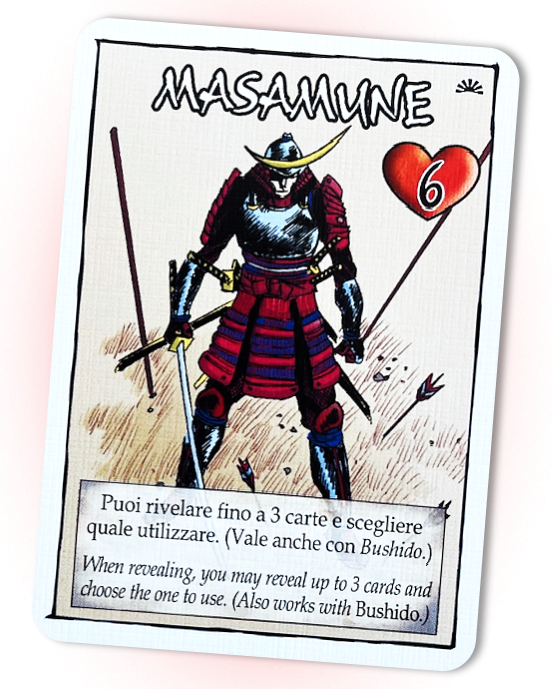
Masamune has the cool ability to peek at up to three cards and pick the best one to use. This helps him plan his next moves smartly.
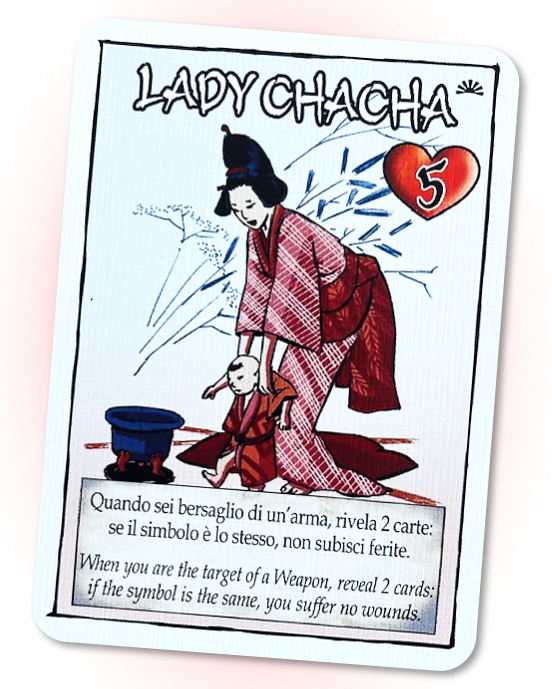
When she’s targeted by a weapon, she can reveal two cards. If one of the cards shows the same symbol as the weapon, she doesn’t get hurt at all. This makes her great at avoiding damage if she’s lucky with her card reveals.
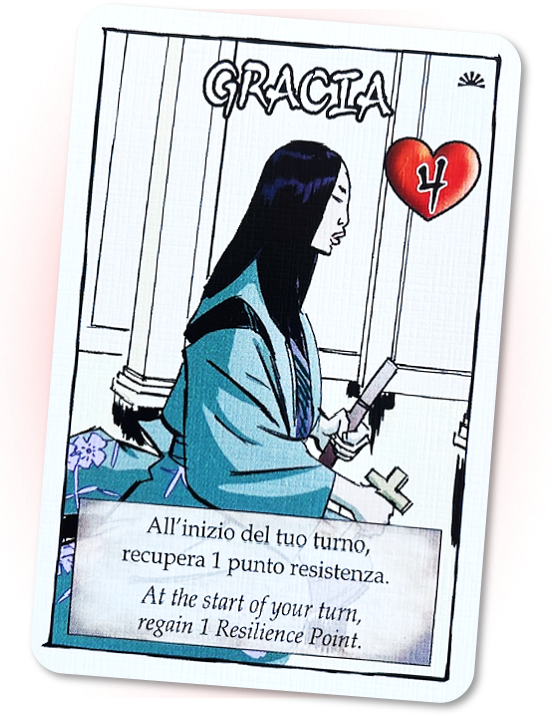
At the start of her turn, if Gracia hasn’t lost any Resilience Points, she doesn’t gain any extra benefits. But if she has a Bleeding Wound, she uses her ability first to try and fix that before the wound affects her.
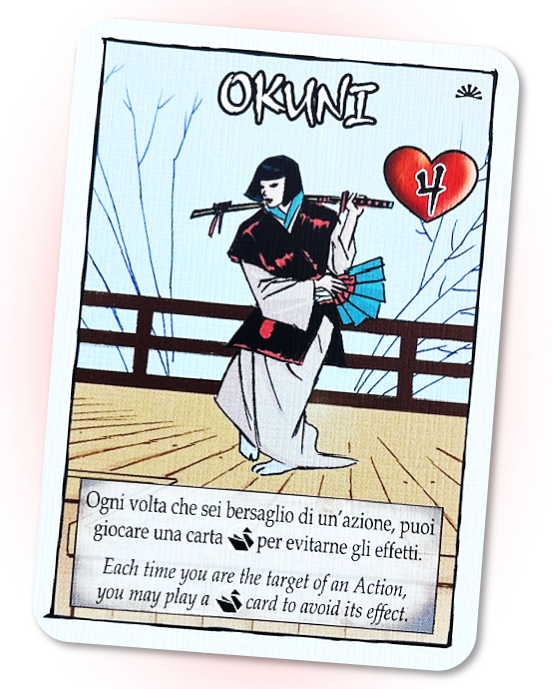
Okuni is great at avoiding group attacks like Jujutsu or Battle Cry, making her less vulnerable to big, collective moves by other players.

Yoshihiro’s special skill only works with weapons. If he gets hurt and loses a Resilience Point because of a weapon, other cards or abilities won’t trigger his effect.
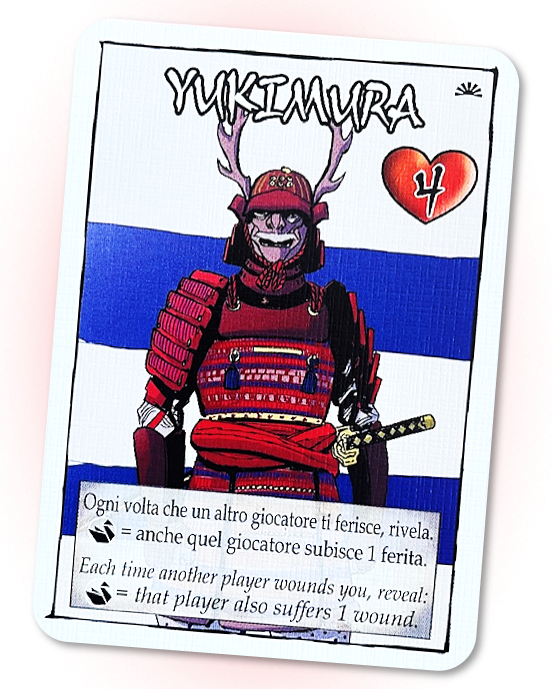
Yukimura has a powerful ability where if he hits you and you lose your last Resilience Point to his attack, you have to give him an Honor Point and end your turn right away. This doesn’t work if you’re already hurt by a Bleeding Wound.
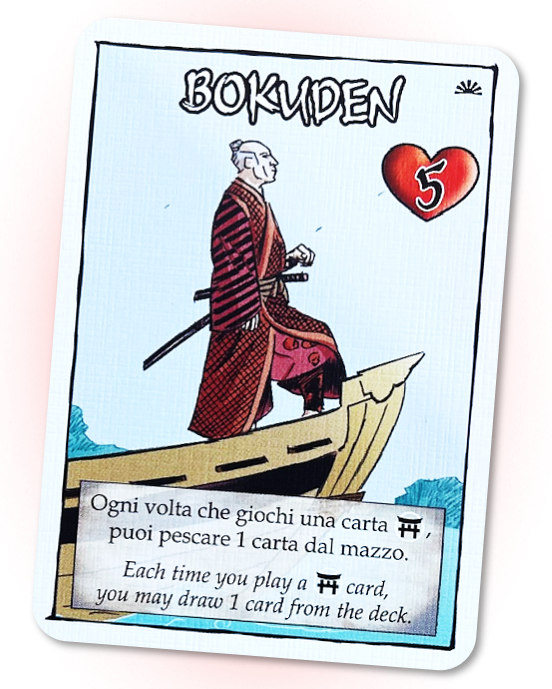
Every time he plays a card with a Shinto temple symbol, he can draw an extra card from the deck. This means he can keep replenishing his hand, making him ready for whatever comes next in the game.
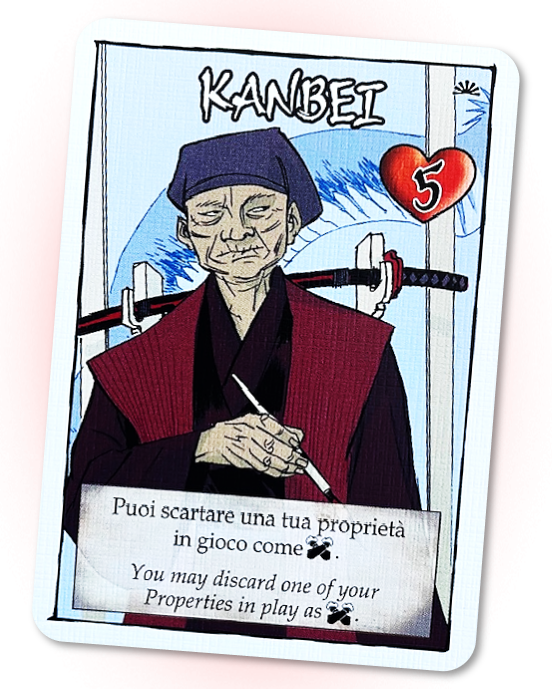
Kanbei can’t use the properties he holds in his hand but he can throw away trouble-causing cards like Bushido, Bleeding Wound, or Curse, which helps him manage bad situations.
Additional New Weapons
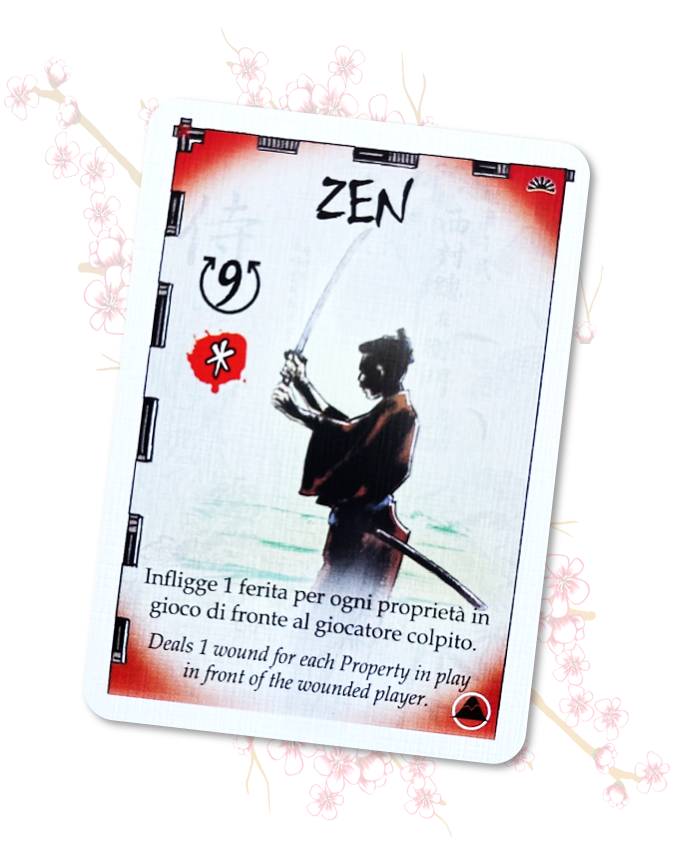
Difficulty: 2
Wounds Inflicted: 1 wound for each Property in play in front of the wounded player.
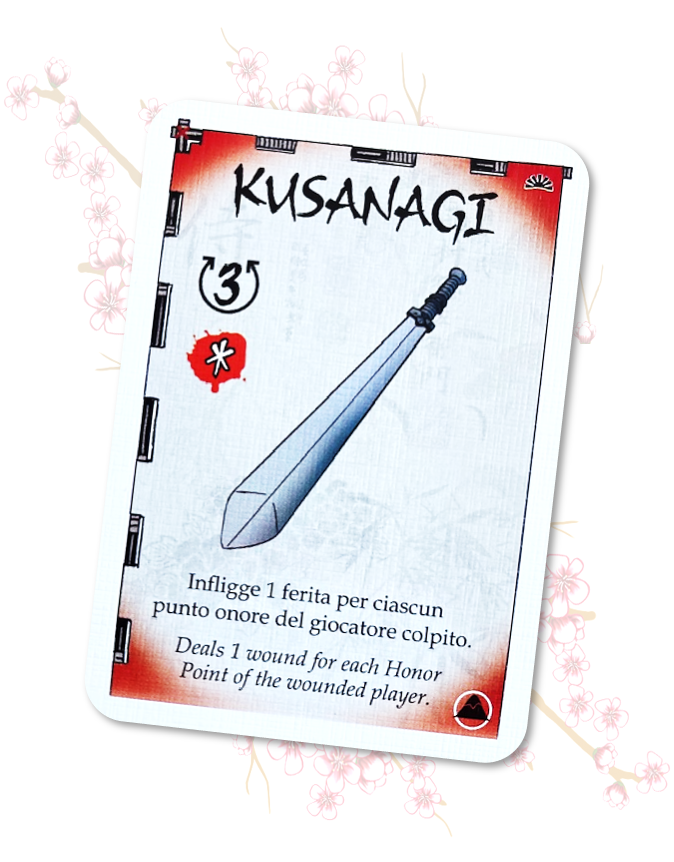
Difficulty: 3
Wounds Inflicted: 1 wound for each Honor Point of the wounded player.
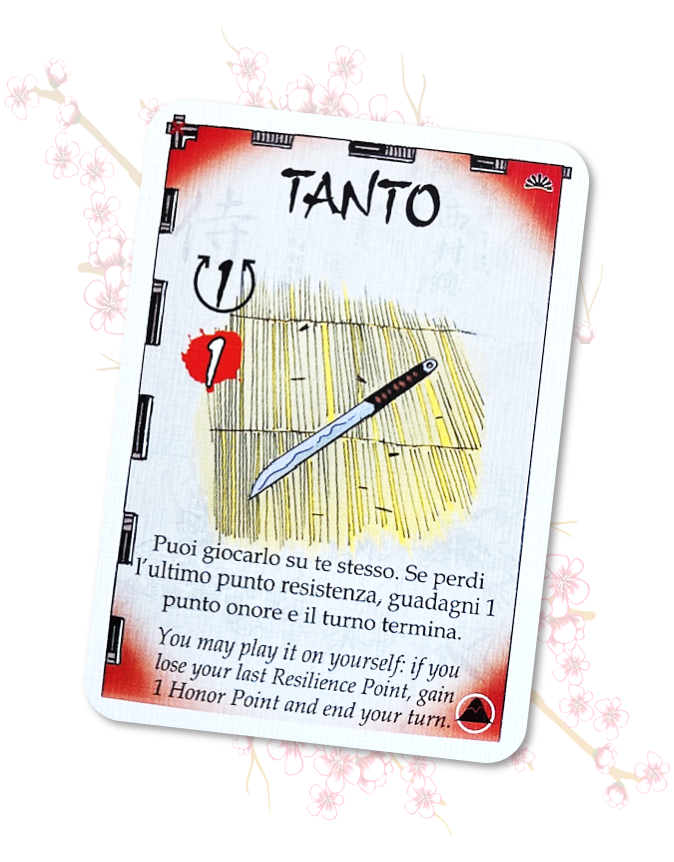
Difficulty: 1
Wounds Inflicted: 1 wound; if used on yourself, you gain 1 Honor Point and end your turn if you lose your last Resilience Point.
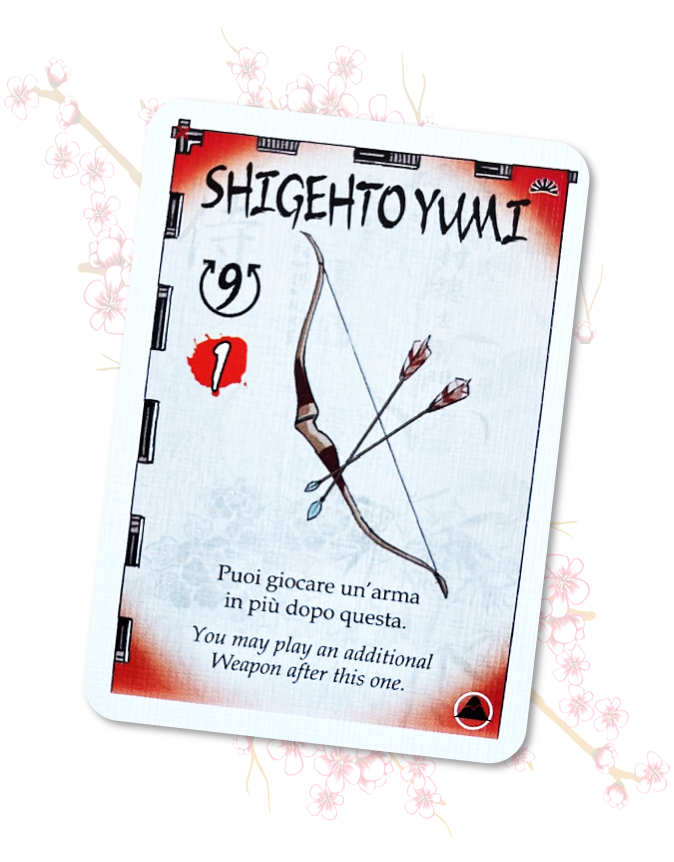
Difficulty: 1
Wounds Inflicted: 1 wound; allows you to play an additional weapon after this one.
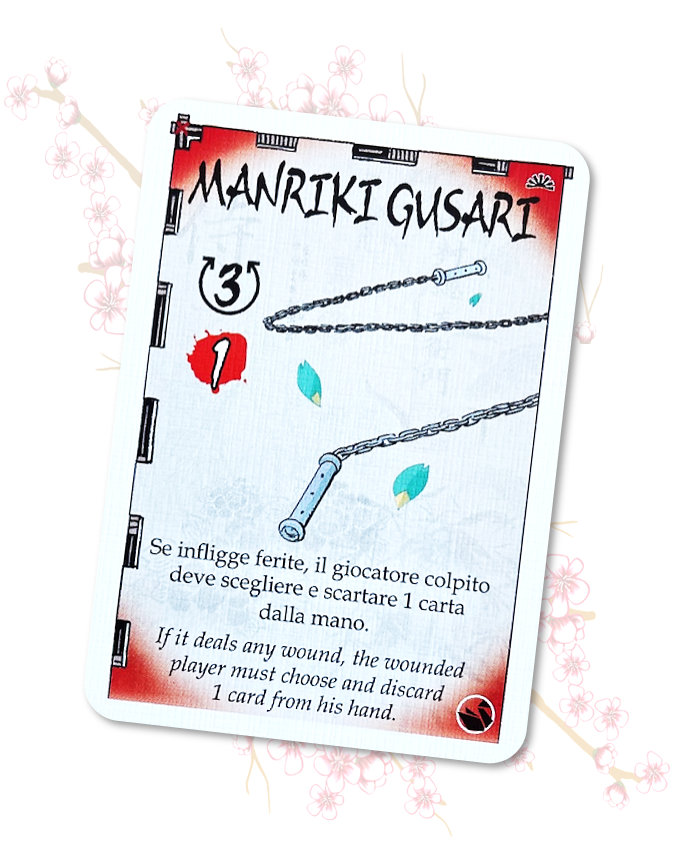
Difficulty: 3
Wounds Inflicted: 1 wound; if it deals any wound, the wounded player must discard 1 card from his hand.
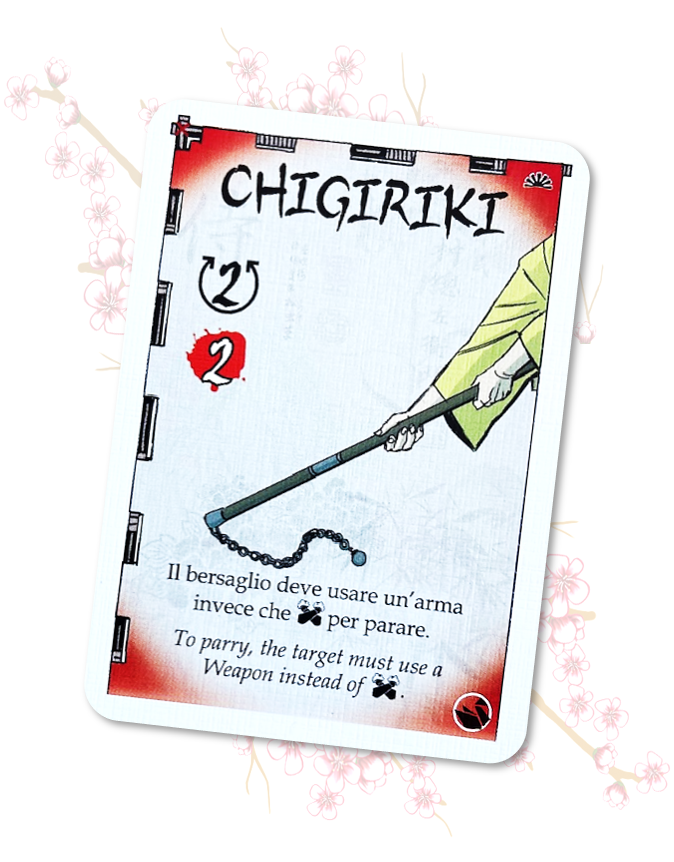
Difficulty: 2
Wounds Inflicted: 2 wounds; the target must use a weapon to parry instead of a Parry card.
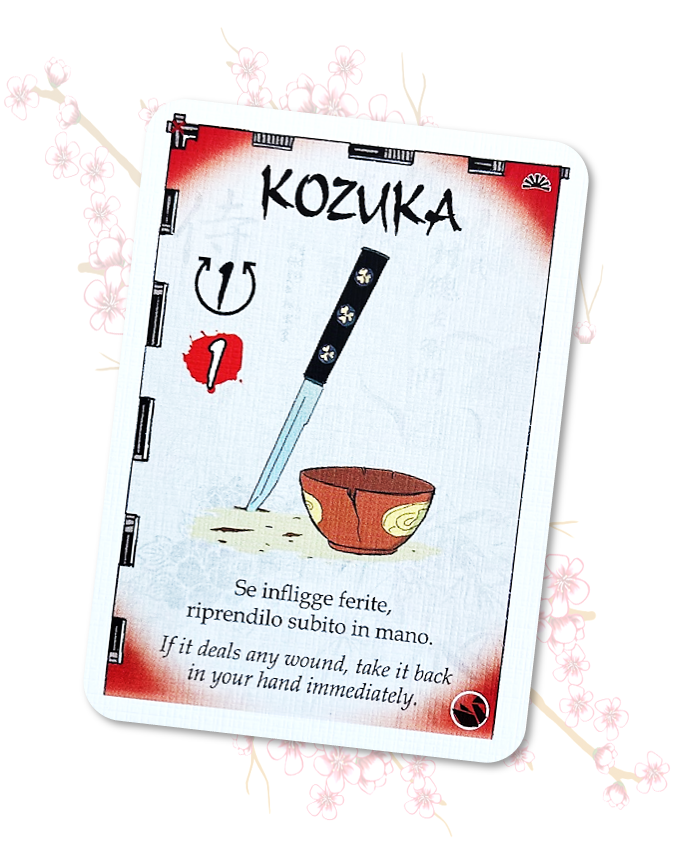
Difficulty: 1
Wounds Inflicted: 1 wound; if it deals any wound, the weapon is taken back into your hand immediately.
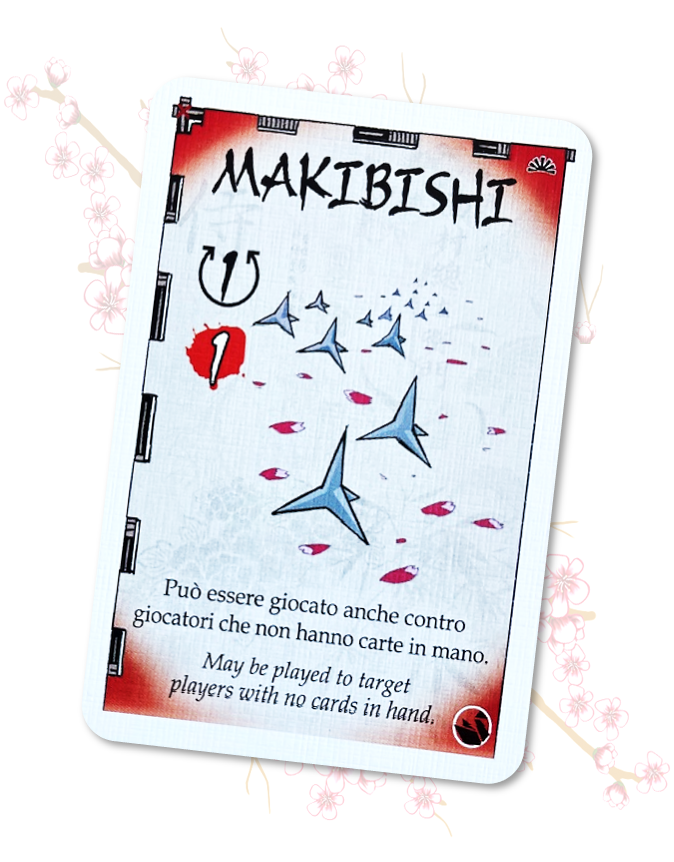
Difficulty: 1
Wounds Inflicted: 1 wound; can be played against players with no cards in hand.
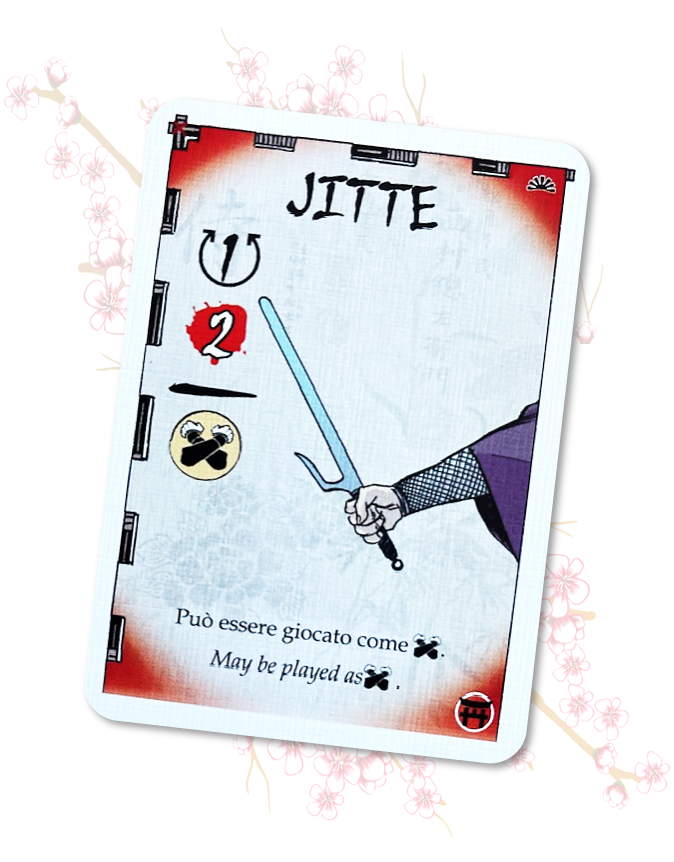
Difficulty: 2
Wounds Inflicted: 1 wound; may be played as a Parry.
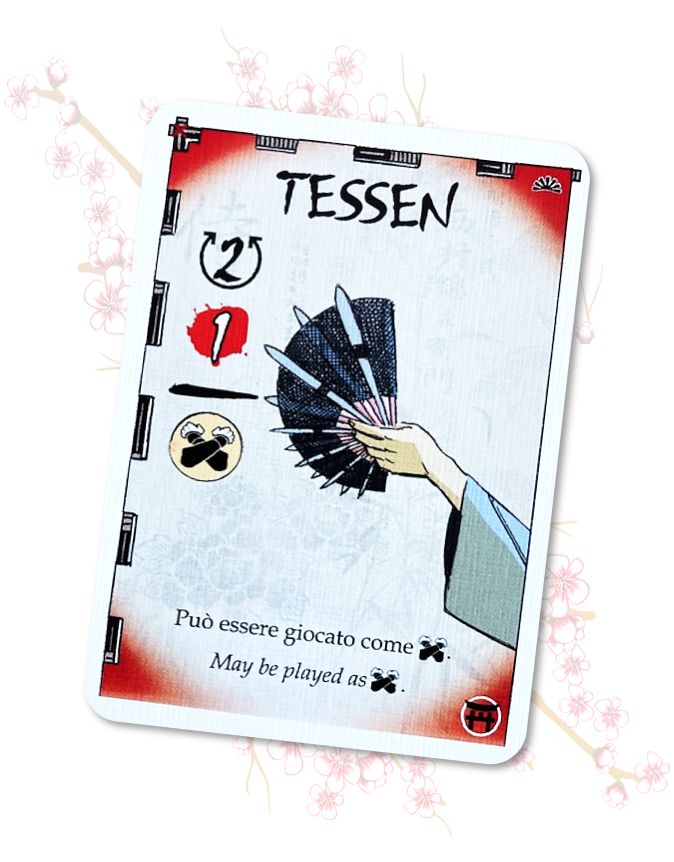
Difficulty: 2
Wounds Inflicted: 1 wound; may be played as a Parry.
Additional New Properties
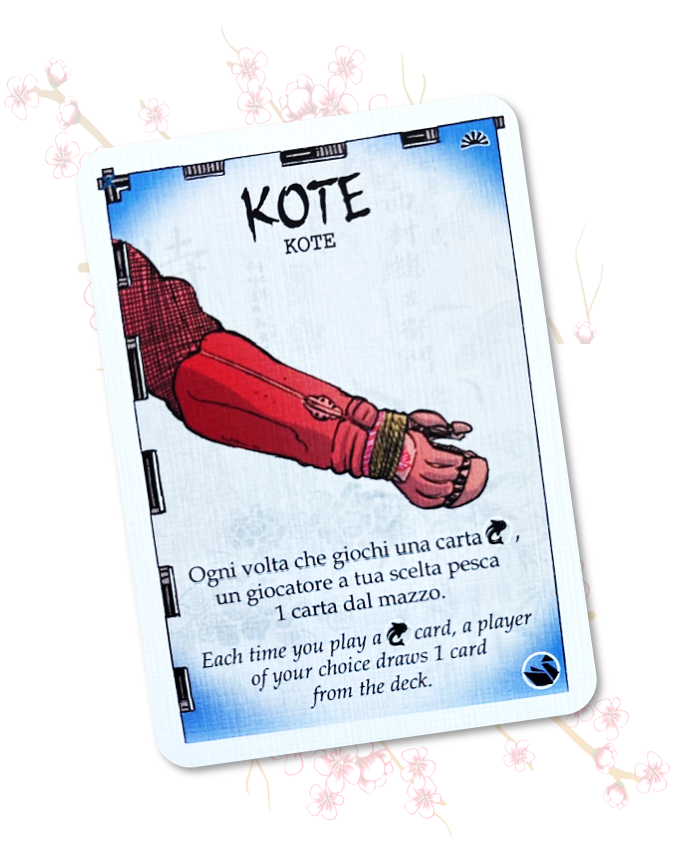
Each time you play a Koi card, a player of your choice draws 1 card from the deck.
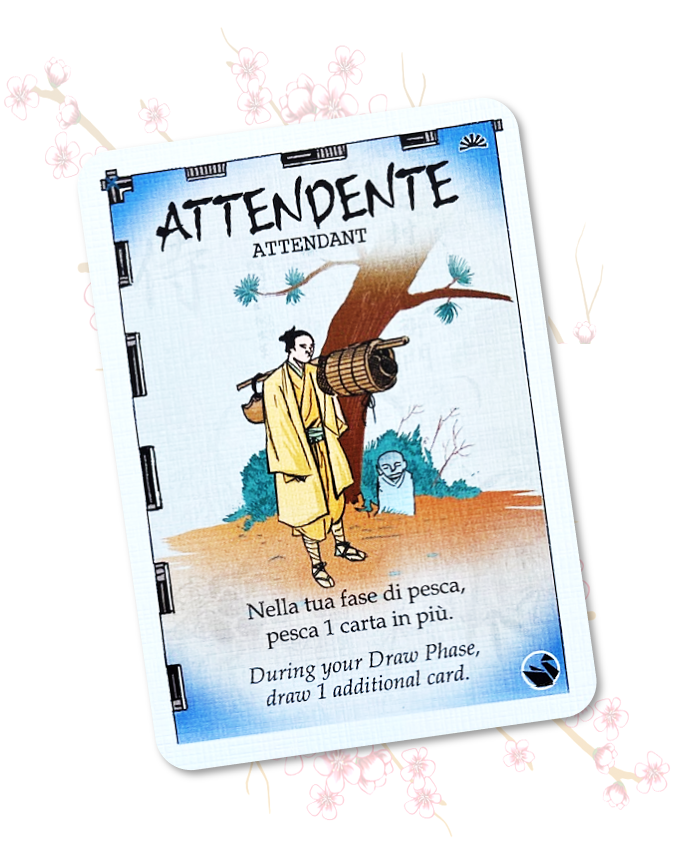
During your Draw Phase, draw 1 additional card.
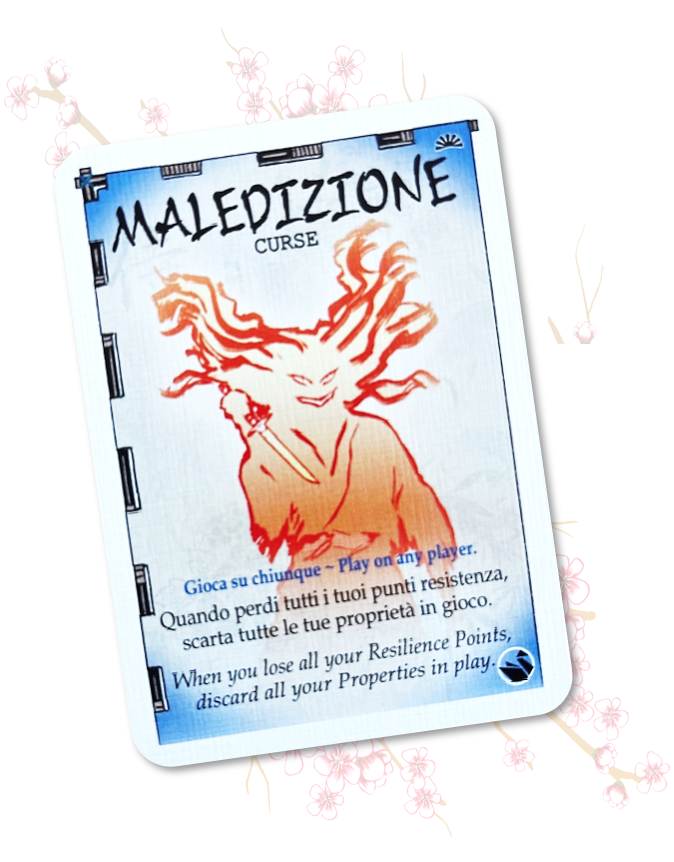
When you lose all your Resilience Points, discard all your Properties in play.
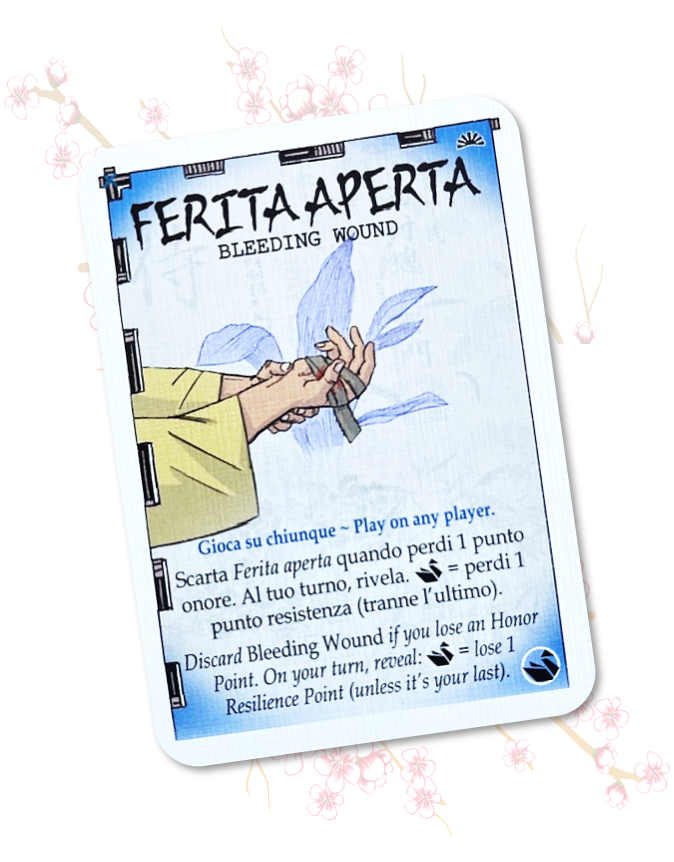
Wound if you lose 1 Honor Point. On your turn, reveal Origami symbol and you lose 1 Resilience Point (unless it’s your last).
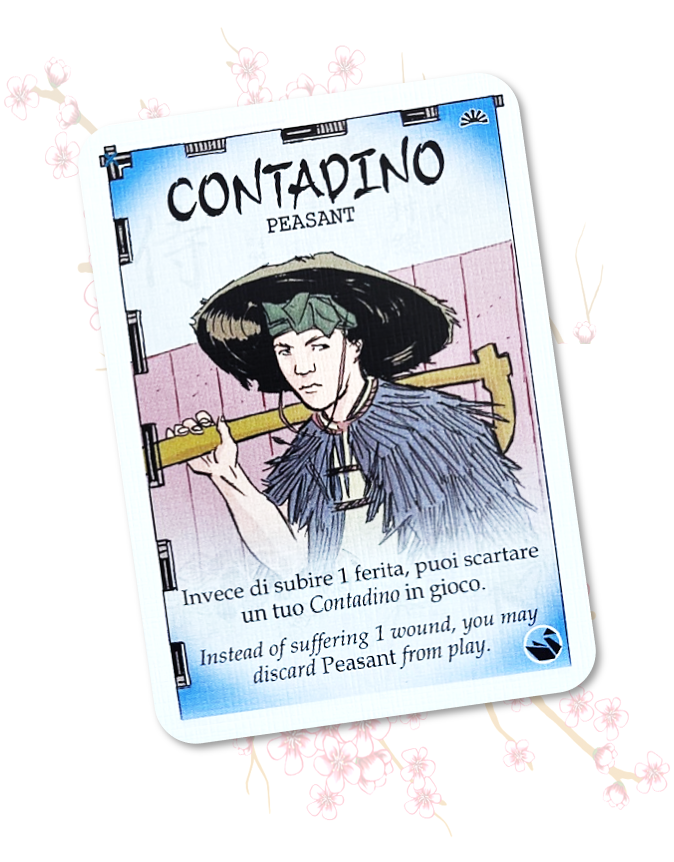
Instead of suffering 1 wound, you may discard Peasant from play.
Additional New Action Cards
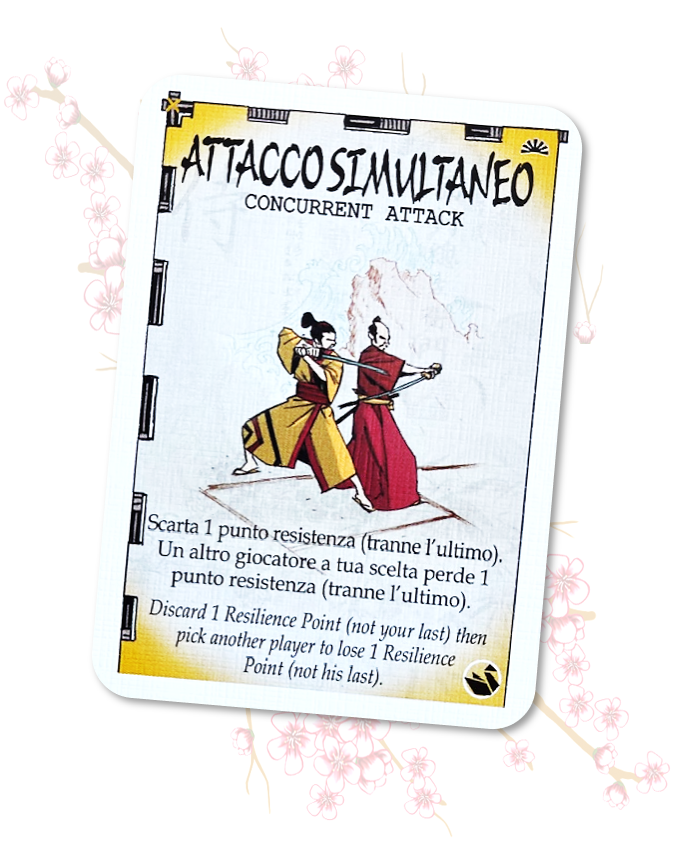
Discard 1 Resilience Point (not your last), then pick another player to lose 1 Resilience Point (not his last). This aggressive card forces both you and another player to lose resilience, making it a risky but potentially game-changing move.
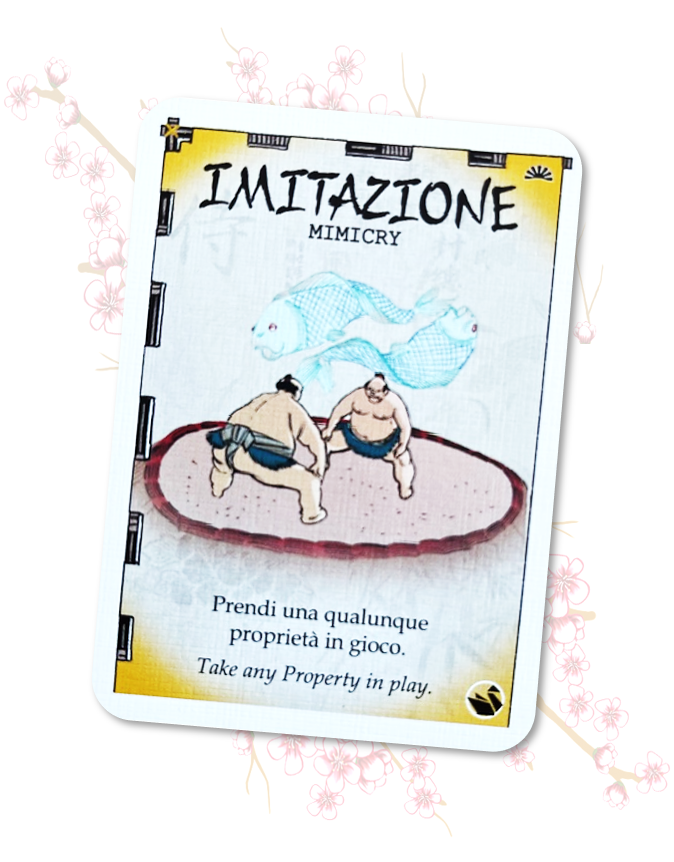
Take any property in play. This allows you to directly influence the game by acquiring key properties from other players, enhancing your own position or weakening theirs.
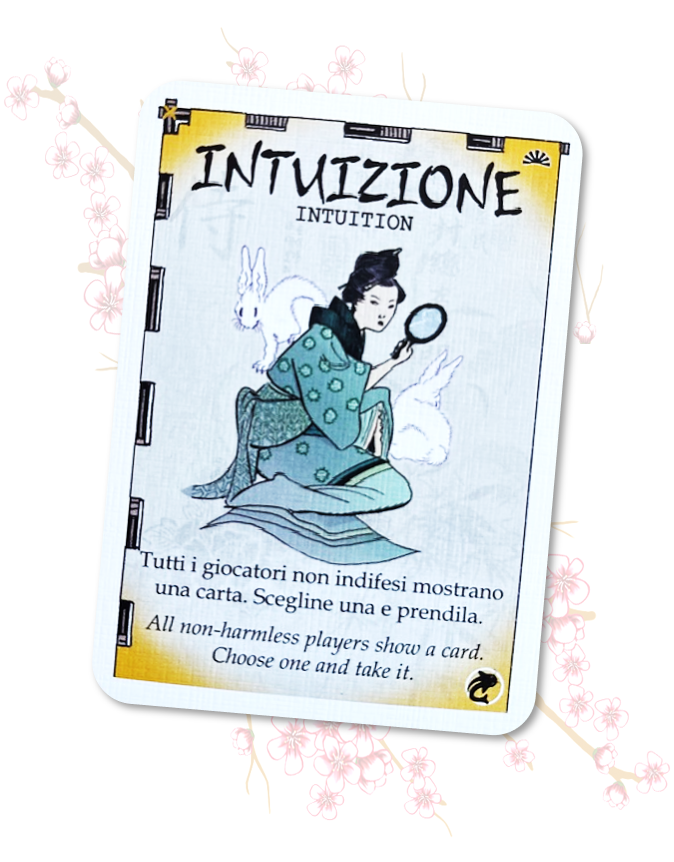
All non-harmless players show a card. You choose one and take it.
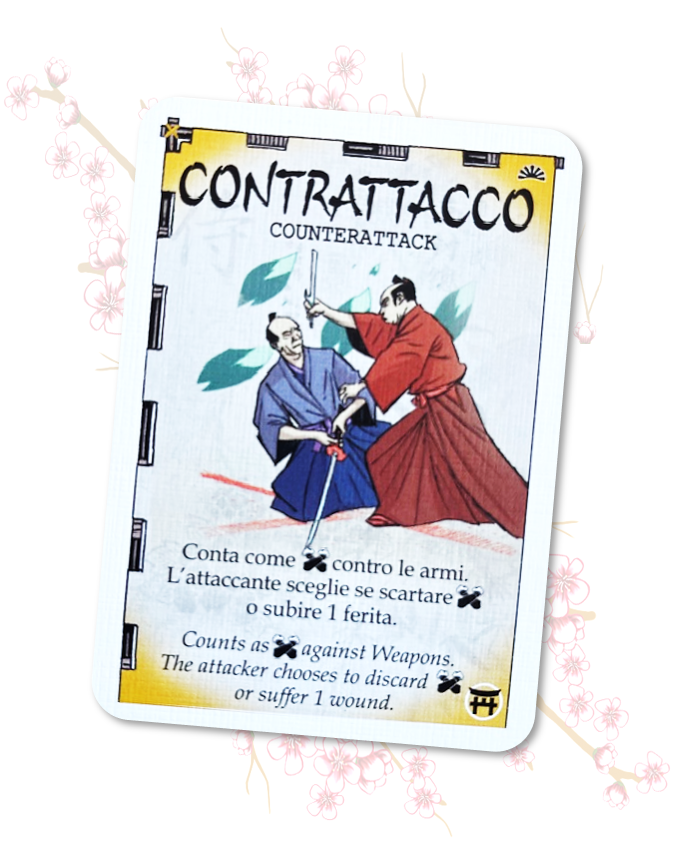
Counts as a Parry against weapons. The attacker chooses to discard a Parry card or suffer 1 wound. This gives you a defensive option that can also turn the tables on the attacker.
Gameplay Changes and Additions
Rising Sun isn’t just about new characters and weapons; it also introduces exciting changes to the rules and game dynamics that can alter how each round unfolds.
Here’s what’s new:
New Rules
1. Banzai!
This new rule adds a dramatic twist. When a player loses all their Resilience Points, they must now immediately discard a number of cards from the draw deck equal to their starting Resilience Points. This simulates a desperate, last-ditch effort to stay in the game, making each character’s endgame even more thrilling.
2. Reveal

Sometimes, the game will ask you to “reveal” a card. This means you’ll flip the top card of the draw deck and check its symbol. If the revealed symbol matches specific requirements, certain abilities or effects are triggered. This adds an element of luck and surprise, making each turn potentially game-changing.
3. Shogun Priority in Ties
The way ties are resolved has changed to add more depth to team strategies. Now, if there’s a tie at the end of the game, the Samurai/Shogun team wins over any other team. However, if the tie is between the Ninja and the Ronin, the Ninja will win, just like in the basic game. This rule emphasizes the importance of team alliances and strategic planning throughout the game.
4. New Rules for Different Number of Players

The Rising Sun expansion introduces tailored rules for 4, 6, and 8 player games, each set designed to balance the game.
Here’s how roles have shifted:
Rules for 4 and 6 Players
Random Samurai Role
At the beginning of the game, we choose one Samurai role card randomly from two options and mix it with other roles. The Samurai card not chosen is put away and not used in that game.

Scoring Changes Based on Samurai Stars

If the Samurai card with 1 star is played, the Shogun’s score at the end of the game is doubled. This means the Shogun becomes more important.
If the Samurai card with 3 stars is played, it’s the Samurai’s score that doubles because of their key role in leading attacks.

Shogun Easy Identification
The Shogun role card has 2 stars on it, which helps everyone remember that the score gets doubled .
Rules for 8 Players

All Role Cards in Play
When there are 8 players, we use all the new roles to make the game exciting. The Shogun starts with 5 Honor Points, and everyone else starts with 4.

Two Ronin in the Game

There are two Ronin, one with 1 star and another with 2 stars, and they are secretly on the same team but don’t know each other.
The Ronin with 2 stars can double their score at the end of the game, showing their hidden strength. The Ronin with 1 star does not get this bonus.
Neither Ronin cares about the Daimyo, which means that role doesn’t help them win.

WEE Wrapping-Up
Hey everyone, it’s Wee! Jumping into the world of Samurai Sword and its expansion, Rising Sun. It’s basically the game Bang! but set in feudal Japan, which is pretty cool if you’re into strategy and a bit of historical flair.
Playing this game is super fun with friends or family because it mixes thinking ahead with some unexpected twists. Just a heads-up, though—there are moments when things can get a bit slow, especially when everyone’s plotting their next move. If you’re all about fast-paced action, this might test your patience a bit.
The Rising Sun expansion is a game-changer. It blends right in with the original game and adds some new characters and roles that spice things up without making everything more complicated. Definitely a must add to everyone’s collection.
You may also like


